A road bike groupset is the collection of components that make you stop and go – in other words, the drivetrain, shifters and brakes.
Plenty of companies make bike components, but the market is dominated by three main brands: Shimano, SRAM and Campagnolo.
Despite the differences between the brands, the components all do the same job, even if there are some subtle variations in how they approach their specific tasks.
We'll start this buyer's guide by explaining the different groupsets available in their hierarchies, then go into greater detail on the individual components and how they differ between brands. We'll finish by explaining the benefits of the more expensive groupsets and discussing compatibility.
If knobbly tyres are more your thing, we've got a separate guide to mountain bike groupsets. We've also got a guide to gravel bike groupsets for all the details on gearing choices.
Jump to:
What is a groupset?
A groupset comprises all the mechanical parts for your bike – so basically everything except the frame, fork, wheels, handlebar, seatpost and saddle.
You can buy a complete groupset or the individual components and there's some possibility to mix and match between groupsets, although many items are not inter-compatible.
When you buy a new bike, a bike brand will often sub in some cheaper parts with a groupset, so you might for example get a crankset that's from a different level or even a different brand from the rest of the groupset.
The components of a full groupset are:
- Crankset (also called the chainset)
- Bottom bracket (the bearings in the frame on which the crankset spins)
- Brake levers/shift levers, usually combined
- Rear derailleur
- Front derailleur
- Cassette (the gear sprockets at the rear of the bike)
- Chain
- Brakes
There's an explainer of each component and more groupset specifics later in this article.
Shimano groupsets: different levels explained
Shimano is the oldest and most widely used of the three main brands. It began life in Japan in 1921 when Shozaburo Shimano decided to start making freewheels in a rented corner of a demolished celluloid factory.
Fast-forward to today, and it's become so successful that Shimano now accounts for at least half of the global bike components industry.
Shimano road groupset ranking
- Claris R2000: 8-speed
- Sora R3000: 9-speed
- Tiagra 4700: 10-speed
- 105 R7100: 12-speed
- 105 Di2 R7150: 12-speed electronic only
- Ultegra Di2 R8100: 12-speed electronic only
- Dura-Ace Di2 R9200: 12-speed electronic only
Entry-level Shimano groupsets: Claris, Sora and Tiagra
Shimano Claris R2000
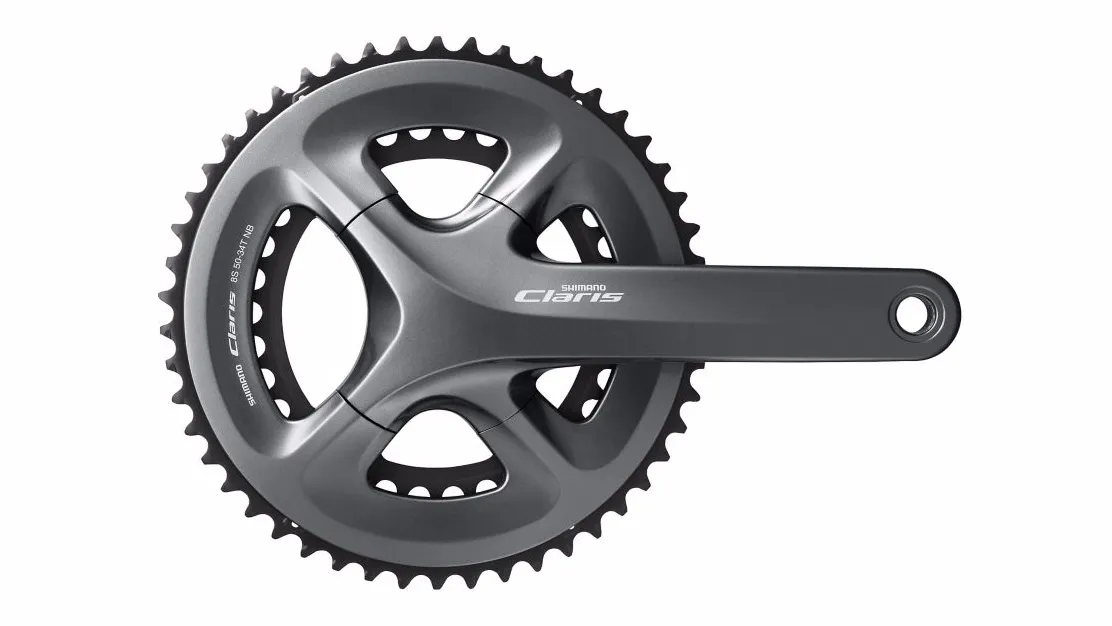
- Gearing: 8-speed
- Shifting: Mechanical
- Braking: Rim
The Shimano component range starts with the budget-priced Shimano Claris, which is usually found on the most affordable bikes available.
Claris is an 8-speed system (eight gears at the rear) combined with either a double or triple crankset (two or three gears at the front). Rim brakes provide the stopping power.
Shimano Sora R3000
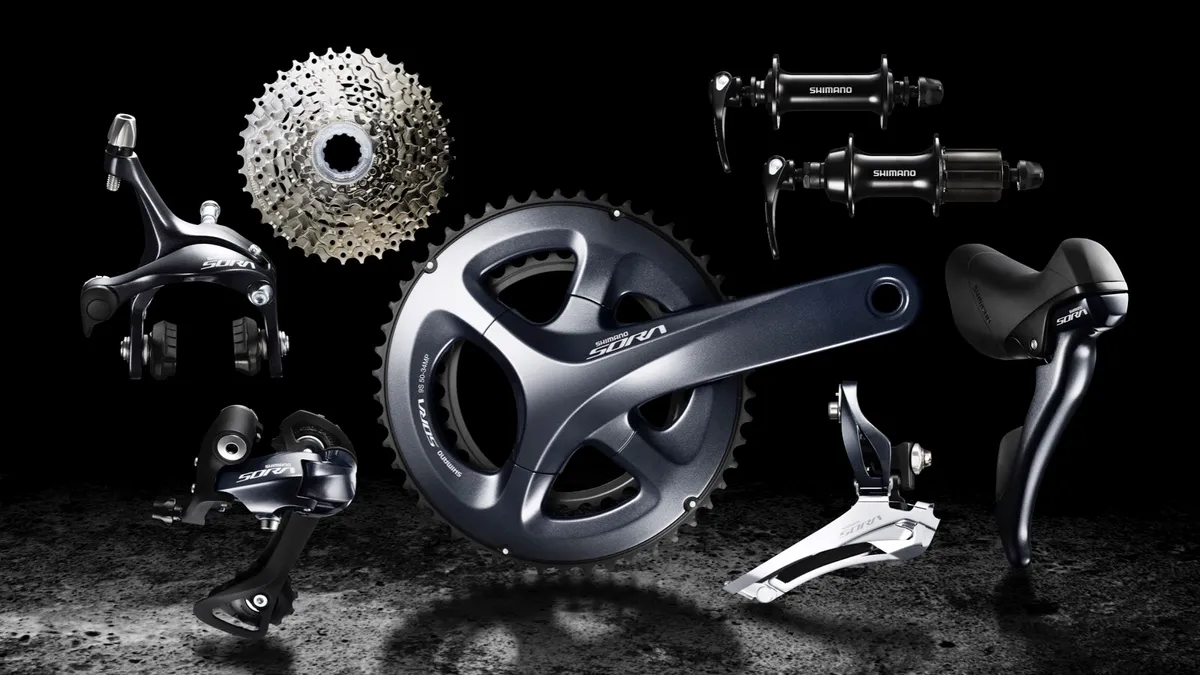
- Gearing: 9-speed
- Shifting: Mechanical
- Braking: Rim, mechanical disc
Next is Shimano Sora, which can also be found on entry-level bikes and is a 9-speed system available in either standard double cranksets or a wide-range triple.
Like Claris, Sora is available with rim brakes only.
Shimano Tiagra 4700
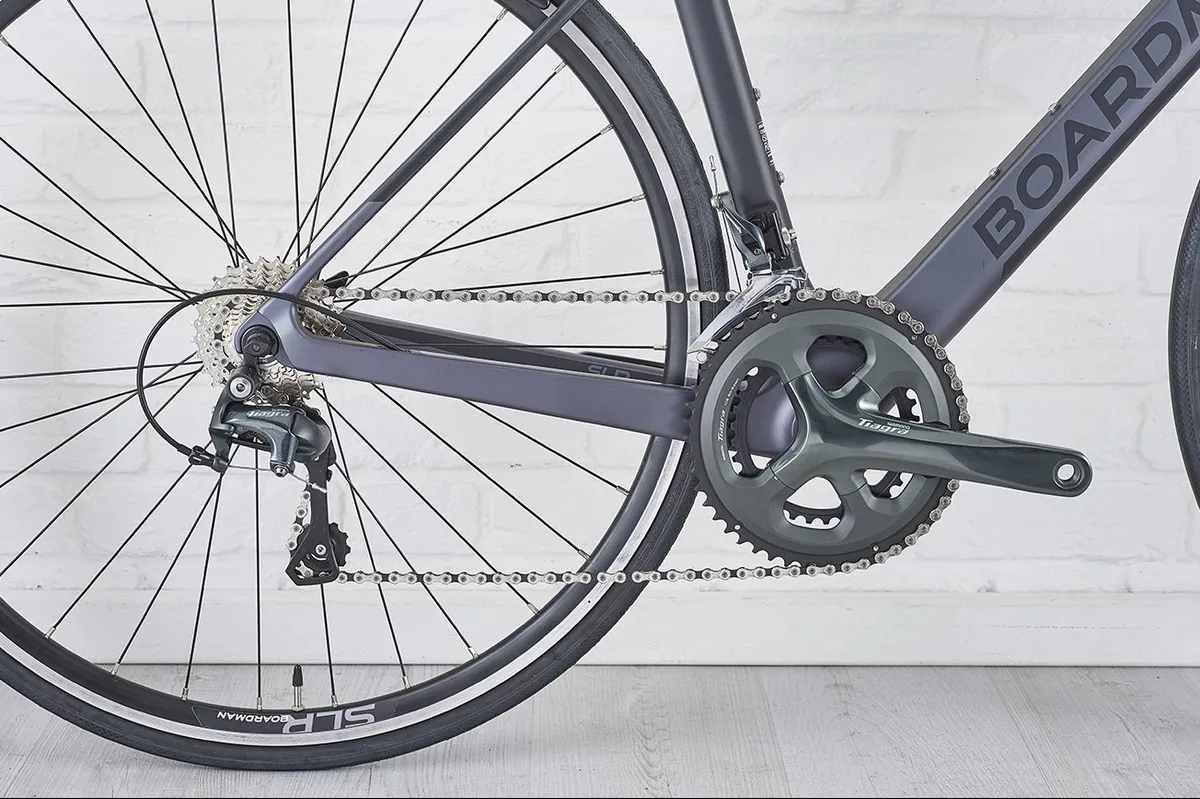
- Gearing: 10-speed
- Shifting: Mechanical
- Braking: Rim, hydraulic disc
Then comes Shimano Tiagra, a 10-speed groupset that offers much of the performance of Shimano 105 (the next step on the ladder), but economises in specific areas, for example with one-piece brake pads rather than higher quality cartridge pads.
Since 2019, Tiagra has included its own hydraulic disc brakes with levers that resemble those of 105. These replaced the lumpy non-series RS405 option. There's a rim brake option, too.
Performance Shimano groupsets: 105 and Ultegra
Shimano 105 R7100
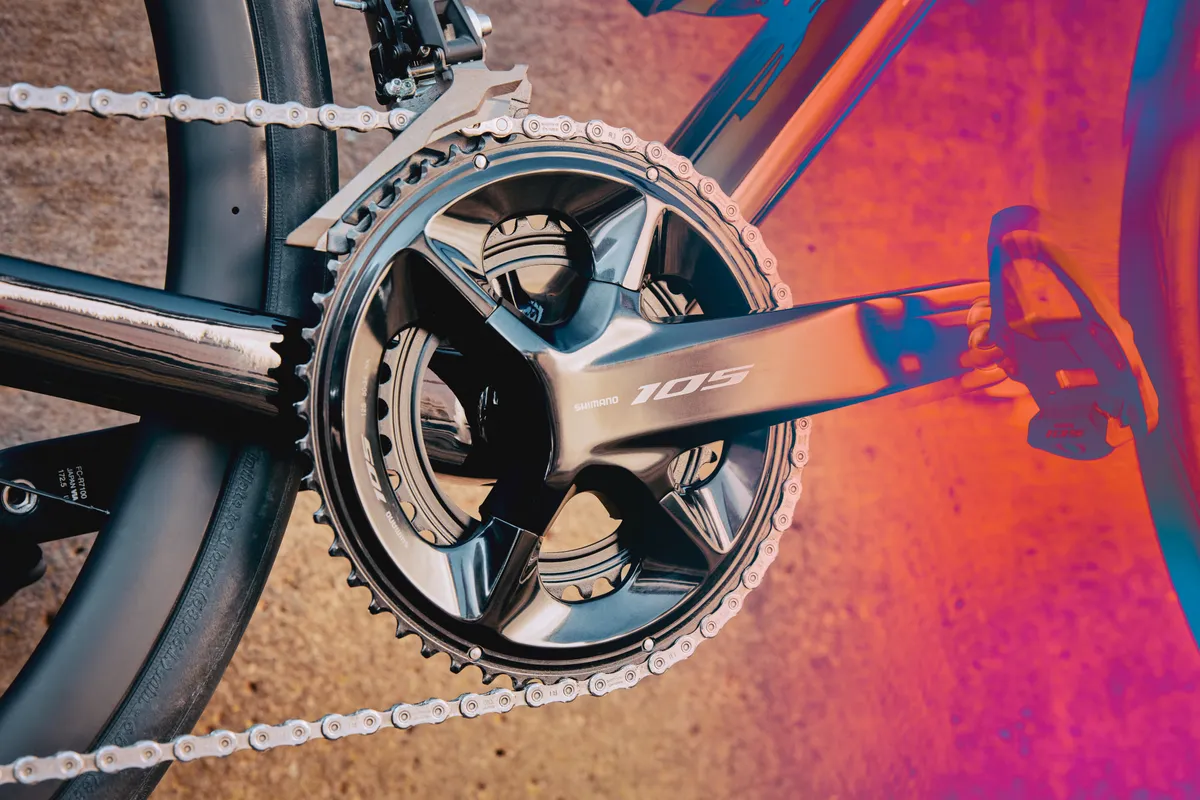
- Gearing: 12-speed
- Shifting: Mechanical
- Braking: Hydraulic disc
Shimano 105 is the most affordable performance-focused groupset from the Japanese firm, and comes on many mid-market road bikes. The new 12-speed R7100-series replaced the 11-speed R7000 line.
This 12-speed group is considered by many riders to offer the best combination of performance, durability and value.
Claimed to weigh 2,845g (depending on spec), the groupset ditches rim brake compatibility and pairs 50/34t or 52/36t cranksets with wide-range 11-34 or 11-36 cassettes.
The cassette cogs use Shimano's Hyperglide profiling, claimed to improve shift quality, but don't get the Hyperglide+ tech found on Ultegra and Dura-Ace.
Depending on the exact spec, the groupset retails for roughly £986.91/$1,192.91/€1,182.85.
Shimano 105 Di2
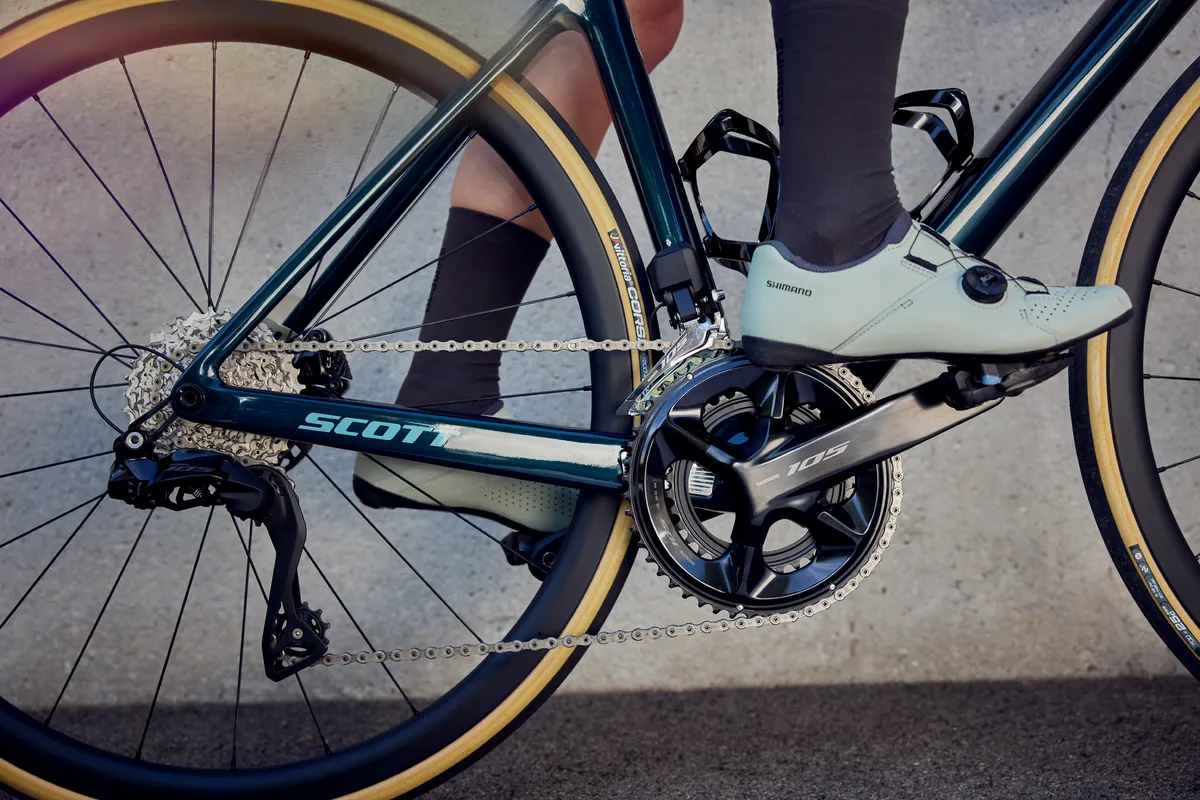
- Gearing: 12-speed
- Shifting: Electronic
- Braking: Hydraulic disc
Shimano 105 Di2 R7150 was released in June 2022. This electronic version of Shimano’s third-tier groupset was long-awaited and now stands in direct competition with SRAM Rival eTap AXS.
The groupset has the same 12-speed gearing and semi-wireless design – meaning the derailleurs are connected to the same battery with the shifters connecting wirelessly – as Shimano Ultegra and Dura-Ace, which were updated in 2021.
Shimano 105 Di2 is claimed to weigh around 2,992g, depending on the spec, and retails for around £1,730 / $1,890 / €1,869.
Unlike the updated Ultegra and Dura-Ace groupsets, Shimano 105 Di2 is disc-brake only. So it’s RIP rim brakes.
For the first time, Shimano introduced 105 carbon fibre wheels with the release of 105 Di2 R7150.
Shimano Ultegra R8100
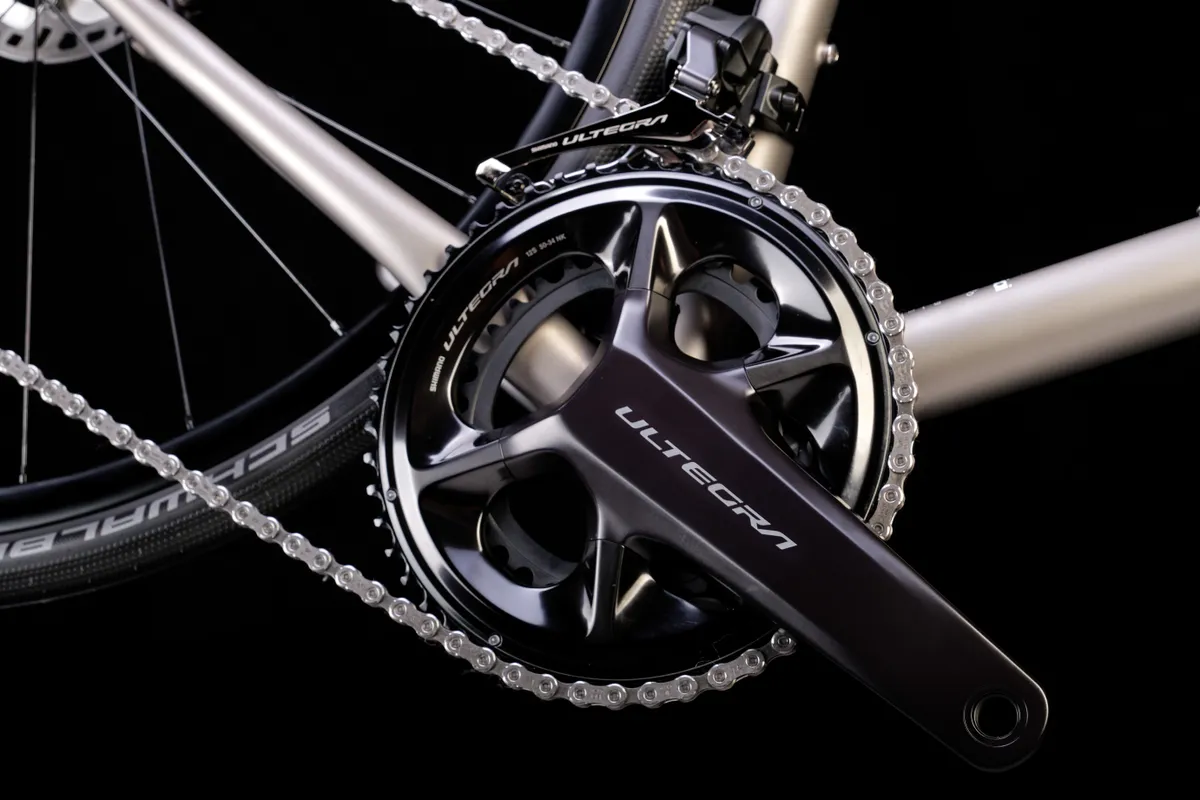
- Gearing: 12-speed
- Shifting: Electronic
- Braking: Rim, hydraulic disc
Shimano Ultegra sits one level below the professional-level Dura-Ace.
Both groupsets were totally revamped in 2021, becoming 12-speed and moving to semi-wireless shifting on the disc brake groupset, where the shifters communicate wirelessly with derailleurs that are wired to a central battery.
Shimano Ultegra R8100 shares essentially all of the same design features as the range-topping Dura-Ace, which we'll come on to. It even includes a power meter option.
As a result, it offers all the performance most riders will ever need, with the only difference to Dura-Ace being a slight weight increase in exchange for a considerable price decrease.
Shimano has ditched Ultegra R8100’s mechanical shifting groupset options and only superficially updated the rim brake electronic option (it is still fully wired), so the Di2 Disc version is the only version of the groupset to contain all the latest developments.
Pro-level Shimano groupsets: Dura-Ace
Shimano Dura-Ace R9200
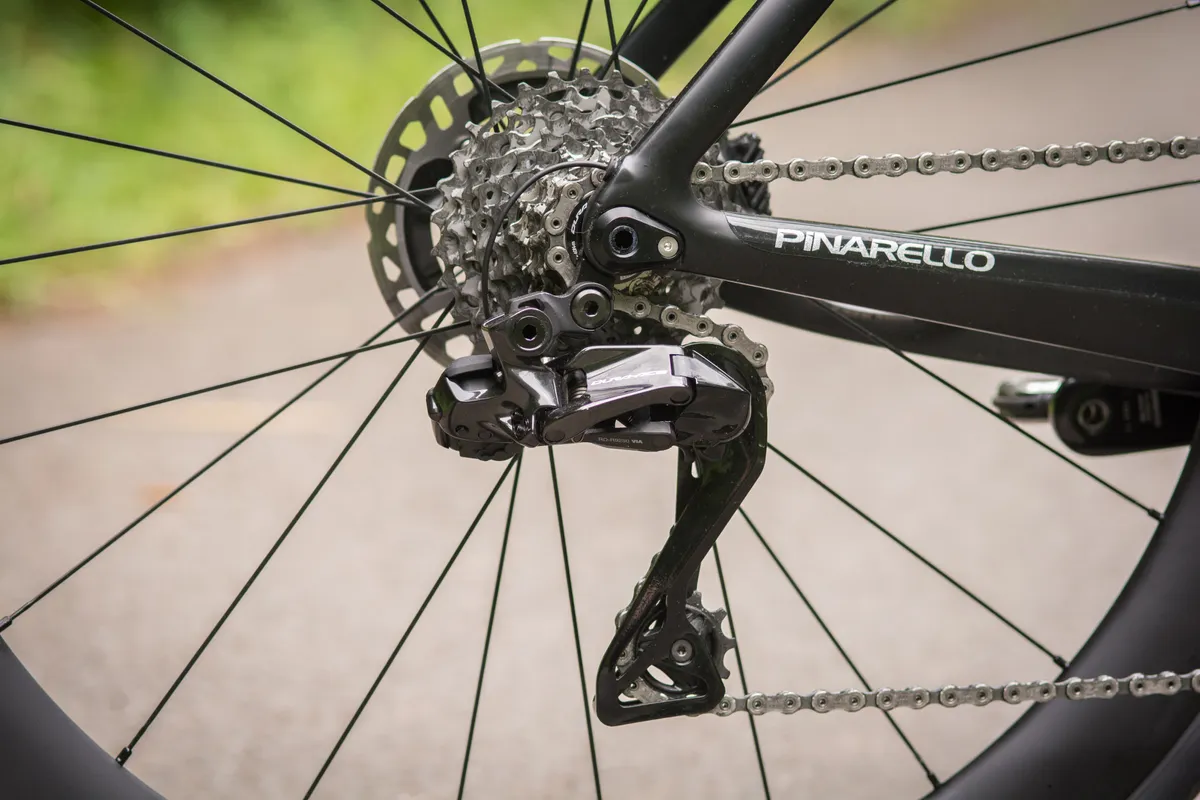
- Gearing: 12-speed
- Shifting: Electronic
- Braking: Rim, hydraulic disc
Shimano Dura-Ace is the pinnacle of Shimano’s range and features on many pro-level WorldTour bikes. It combines top-end design with lightweight materials, such as high-grade alloys, carbon fibre and titanium.
Overhauled in 2021 at the same time as Ultegra and with similar improvements, the new Shimano Dura-Ace Di2 R9200 now offers 12-speed gearing and semi-wireless shifting that claims to be faster than the previous generation Dura-Ace R9170 Di2 groupset.
The Ultegra and Dura-Ace disc brakes systems have been similarly tweaked. They now use Shimano’s Servo Wave lever ratio for improved modulation, while the calipers offer ten per cent more clearance, making them easier to get running silently, according to Shimano.
Just as in Ultegra R8100, Shimano has killed off the mechanical shifting option for Dura-Ace R9200 and has only made modest changes to the rim brake version of the groupset, meaning the only guise in which all the latest developments are included is the Di2 Disc option.
Dura-Ace is more expensive but lighter than Ultegra, and it also offers a bigger 54-40t chainset option to better cater to the faster speeds of pro riders. Aside from that, the two groupsets are functionally the same.
SRAM groupsets: different levels explained
SRAM came to the fore during the mountain biking boom of the late eighties and established itself off the back of its lightweight GripShift shifters.
SRAM introduced its lightweight Red road groupset in 2007 and now produces an extensive range of components for road and cyclocross bikes, alongside its mountain bike groupsets.
SRAM's road groupset range comprises four main groups: Apex, Rival, Force and Red (low to high, in terms of price). All of its road groupsets now include a hydraulic disc brake option.
All of its groupsets are offered in 12-speed wireless electronic variants, with the addition of gravel-specific gearing.
Note SRAM Apex is only available in a 1x drivetrain configuration, so while it is possible to use on the road, the brand positions it as a gravel groupset.
With the focus on electronic groupsets, SRAM hasn't made major updates to its mechanical groupset range for some years now.
SRAM groupset ranking
- Apex 1: 11-speed
- Apex: 12-speed
- Apex AXS: 12-speed wireless electronic
- Rival: 11-speed
- Rival eTap AXS: 12-speed wireless electronic
- Force: 11-speed
- Force AXS: 12-speed wireless electronic
- Red: 11-speed
- Red AXS: 12-speed wireless electronic
Performance SRAM groupsets: Apex 1, Apex, Apex AXS, Rival, Rival eTap AXS, Force and Force AXS
SRAM Apex 1

- Gearing: 11-speed, 1x drivetrain only
- Shifting: Mechanical
- Braking: Rim, hydraulic disc
SRAM Apex 1 is the brand's entry point to its road range, pairing a 1x crankset with either an 11-26, 11-28, 11-32, 11-36 or 11-42t cassette.
Unlike the brand's higher-tier options, which feature a 10t starting cog, Apex starts with 11t, meaning the cassette can fit onto a conventional HG freehub.
Apex 1 is compatible with drop-bar and flat-bar bikes, thanks to a flat-bar shifter option, so you'll commonly find it on the best hybrid bikes.
SRAM Apex
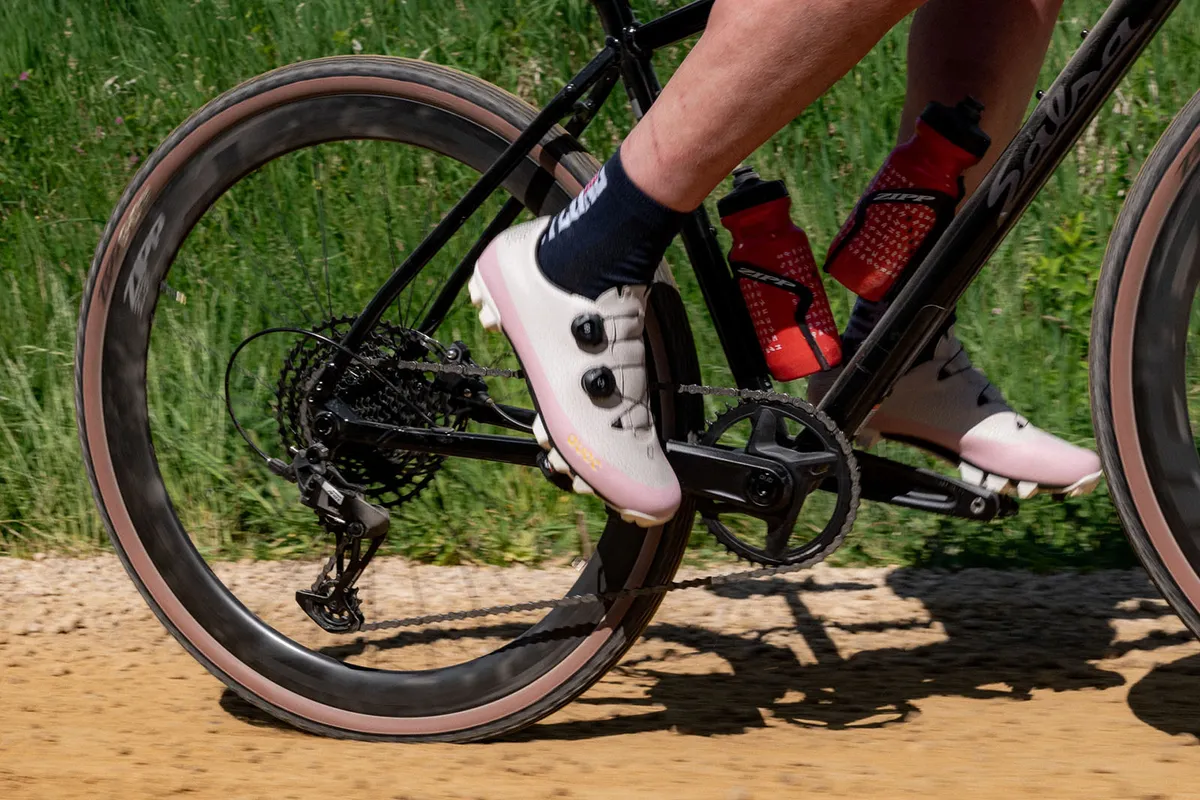
- Gearing: 12-speed
- Shifting: Mechanical
- Braking: Hydraulic disc
SRAM gave Apex the 12-speed treatment in 2023, with the groupset aimed squarely at gravel riding, bikepacking, commuting and everything in between. Like Apex 1, there are drop-bar and flat-bar shifter options and you can pick between an XPLR 11-44t cassette or a wider-ranging Eagle 11-52t cassette.
The cassette's continue to start with an 11t, meaning they run on a HG freehub. SRAM claims the groupset weights start from 2,872g and there's even an optional power meter.
SRAM Apex AXS
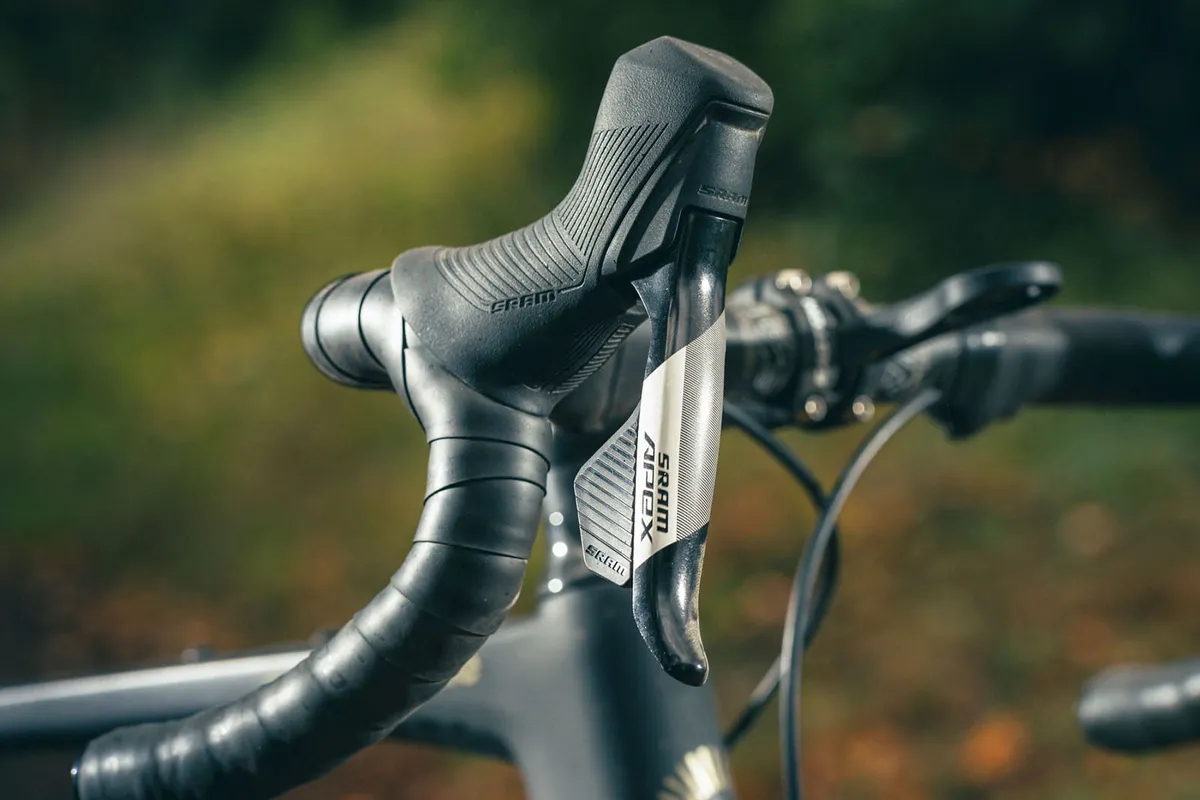
- Gearing: 12-speed
- Shifting: Electronic
- Braking: Hydraulic disc
SRAM trickled down its wireless technology to Apex in 2023, with the fourth-tier groupset retailing for £1,262 / $1,195 / €1,411.
Like Apex, you can pick between an 11-44 or an 11-52t cassette and the shifters use identical AXS shifting logic to Rival, Force and Red. They also share the same electronics and motors, as well as the brake design, so performance should be comparable to the higher-tier options, albeit with a weight penalty.
SRAM Rival
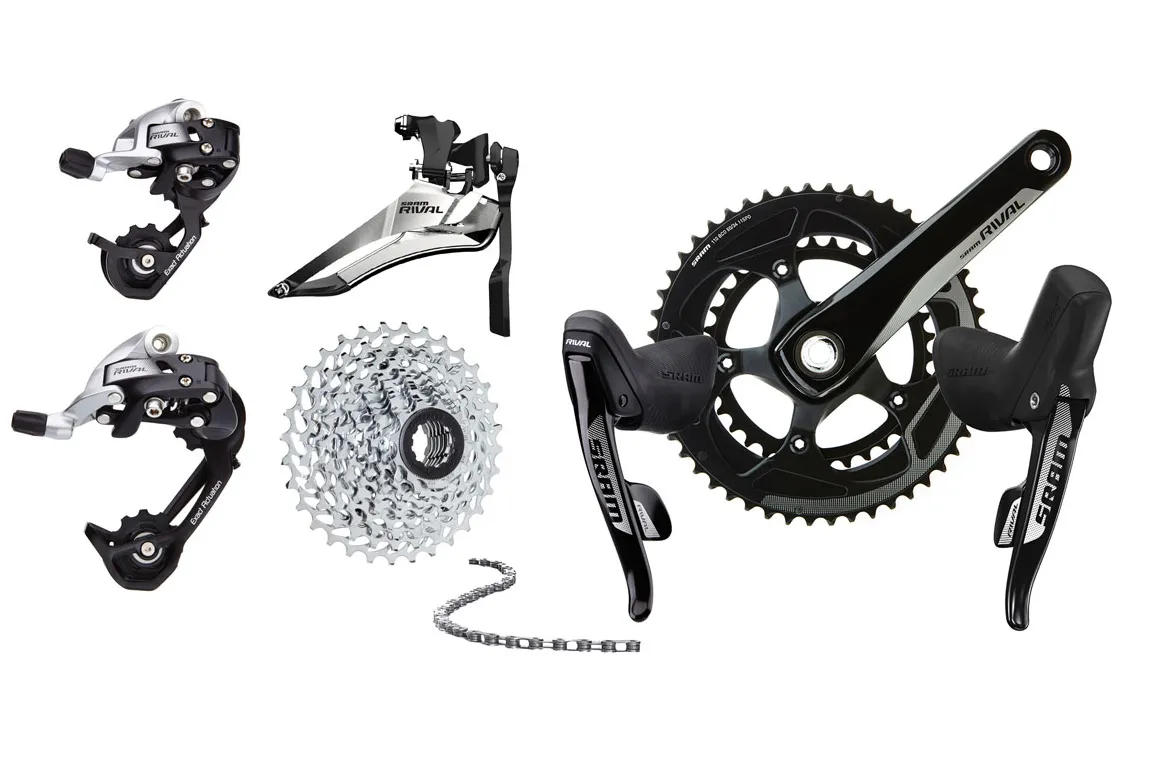
- Gearing: 11-speed
- Shifting: Mechanical
- Braking: Rim, hydraulic disc
SRAM Apex used to open the American brand's range but it has now been repositioned as two gravel groupsets.
That makes Rival first in line on the road. It's made from lighter materials than Apex and there's the option to use it with a wide-range WiFli rear derailleur and cassette if you're after easier gear ratios.
Rival with mechanical shifting is 11-speed and can be found with either two chainrings at the front (2×11) or just one (1×11) in the Rival 1 configuration.
SRAM Rival eTap AXS
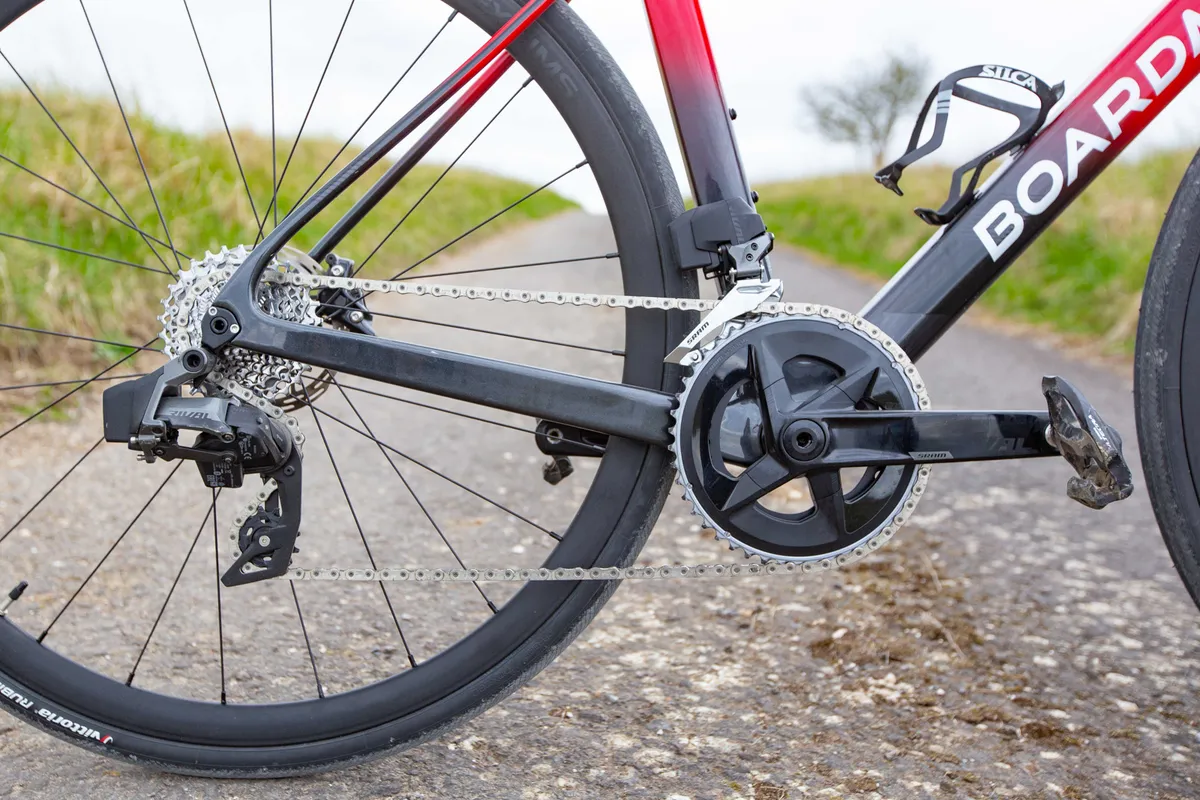
- Gearing: 12-speed
- Shifting: Electronic
- Braking: Hydraulic disc
In 2021, SRAM launched Rival eTap AXS.
It adds a third tier to SRAM's wireless electronic 12-speed groupset line-up and uses much of the same tech as SRAM's pricier options, offering app-based configuration via a smartphone and a power meter.
SRAM Force
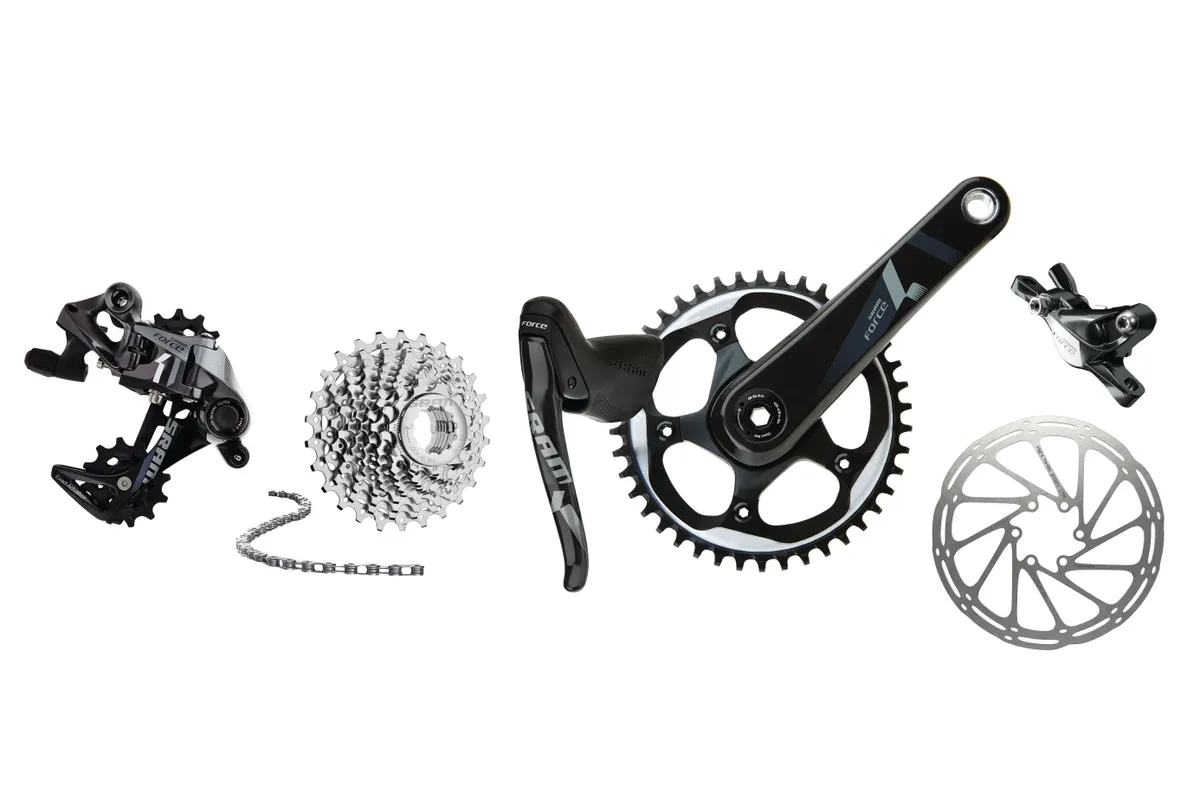
- Gearing: 11-speed
- Shifting: Mechanical
- Braking: Rim, hydraulic disc
Going up in spec one level, SRAM's Force group uses lightweight materials such as high-grade alloys and carbon fibre to offer a lightweight mechanical setup.
Like Rival, it's an 11-speed groupset that can be configured with two chainrings at the front for more gearing range or one chainring (SRAM Force 1) at the front for simplicity.
SRAM Force AXS
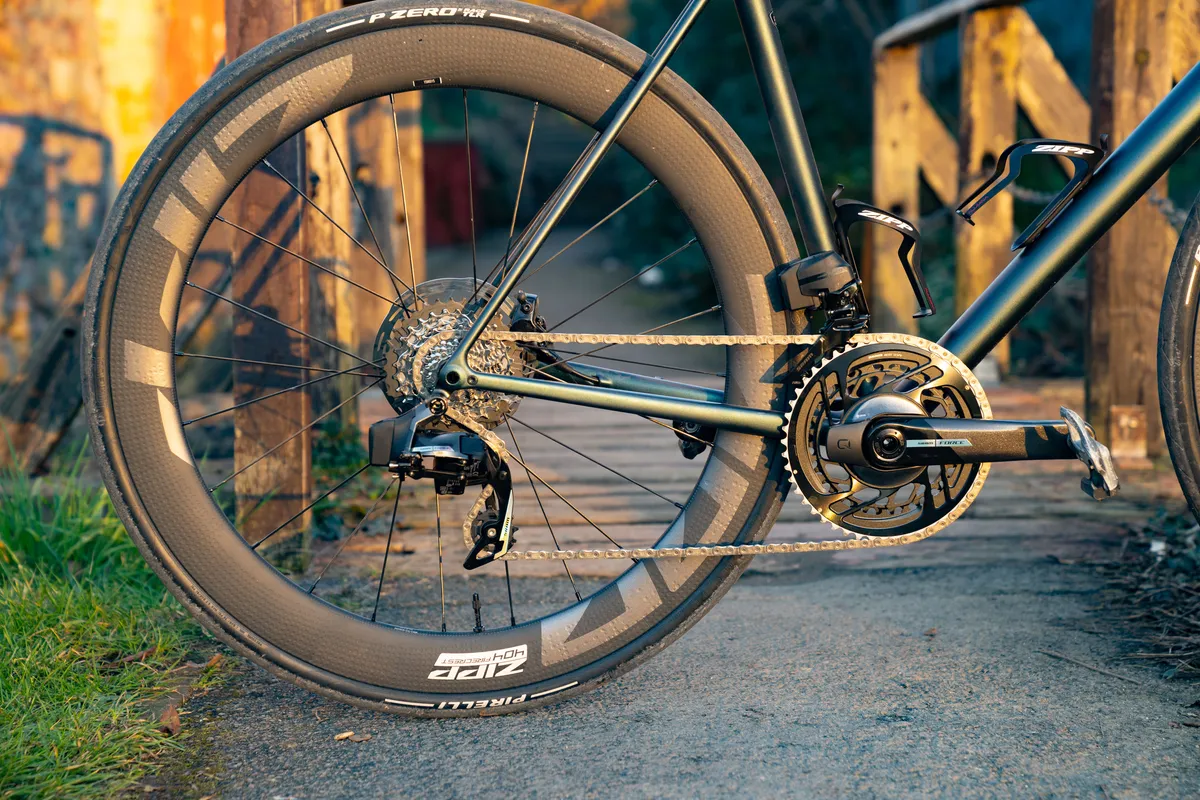
- Gearing: 12-speed
- Shifting: Electronic
- Braking: Hydraulic disc
SRAM launched its second-generation Force AXS groupset in March 2023, a 12-speed wireless groupset that competes directly with Shimano Ultegra Di2 and offers several power meter options.
It's very similar to the outgoing Force eTap AXS, with new aesthetics as well as more compact shifters and a faster-operating front derailleur.
Like Red, Force uses a direct-mount crankset, which sees the crank arms and chainrings paired together without chainring bolts or a separate spider.
There's a wide range of components covering road and gravel use, with Force AXS also available in XPLR gravel gearing.
Pro-level SRAM groupsets: Red and Red AXS
SRAM Red
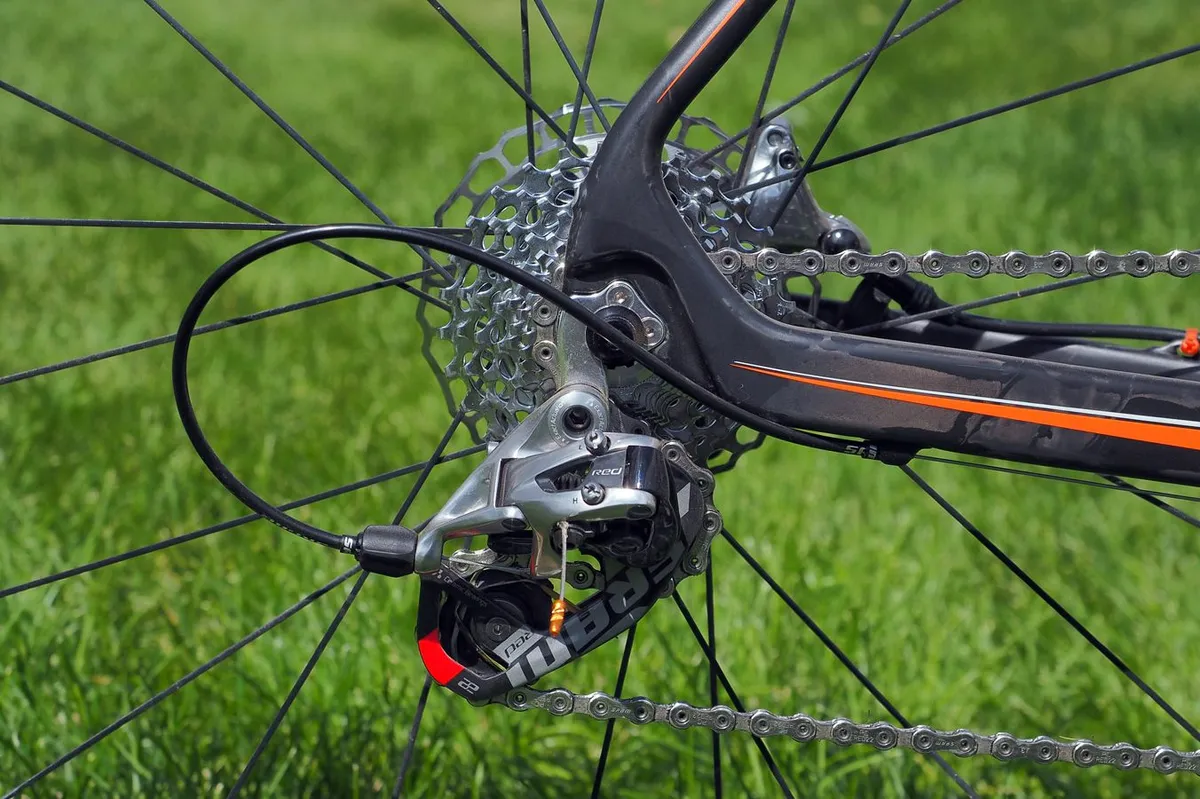
- Gearing: 11-speed
- Shifting: Mechanical
- Braking: Rim, hydraulic disc
SRAM Red is a pro-level 11-speed groupset and was originally launched as a direct competitor to Shimano Dura-Ace and Campagnolo Super Record.
SRAM Red components use super-light materials throughout, including high-grade alloys, plenty of carbon fibre, titanium and even ceramic bearings. SRAM Red is also available in a WiFli option, allowing for an ultra-wide range of gears.
Of all the top-of-the-range groups, SRAM Red is almost certainly the lightest on the market at a claimed 1,747g. Note that it's difficult to make precise weight comparisons between groupsets because there's no standard for how to weigh one.
SRAM's efforts have been focused on its wireless eTap AXS groupsets in recent years, so while mechanical Red is still in existence, it's fairly long in the tooth and only likely to be seen on used bikes.
SRAM Red AXS
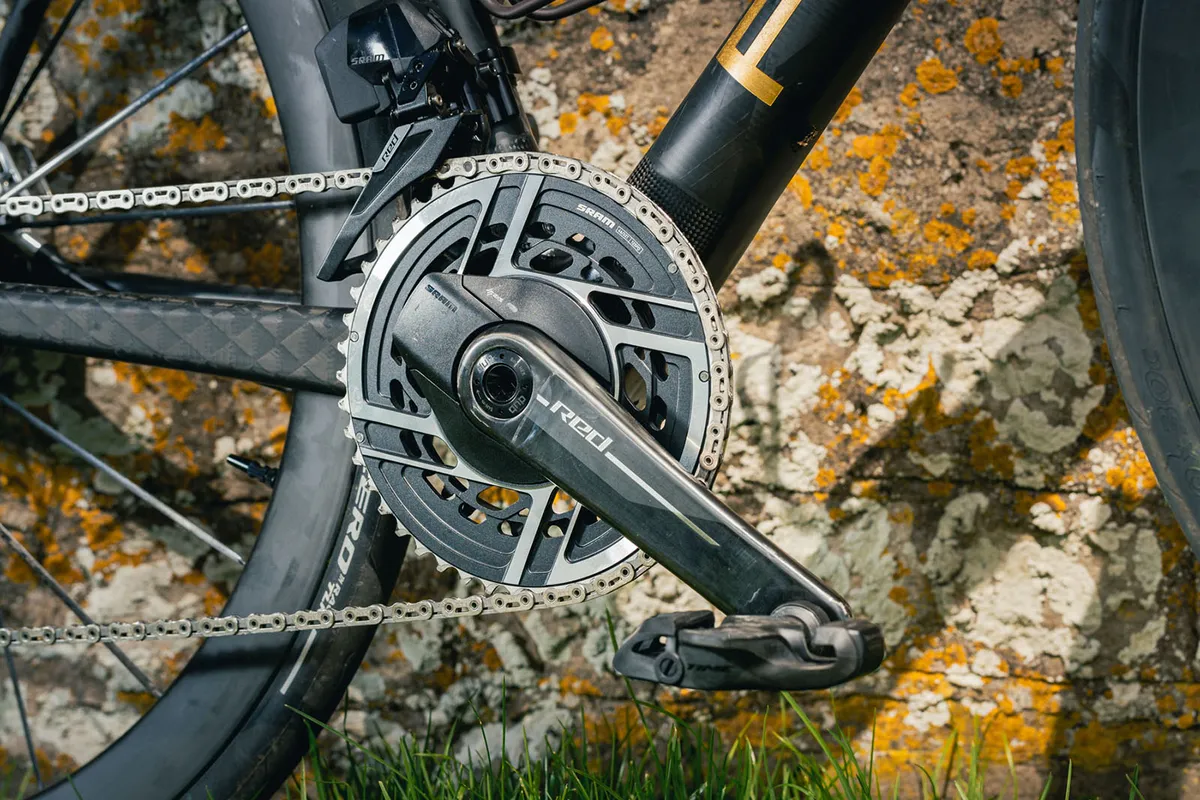
- Gearing: 12-speed
- Shifting: Electronic
- Braking: Hydraulic disc
SRAM Red eTap launched in 2015, as a wireless electronic version of the 11-speed Red groupset. That original launch was superseded by the 12-speed Red eTap AXS in 2019 and was updated in 2024.
SRAM Red AXS is claimed to be the lightest electronic disc brake groupset on the market, shaving 154g from the previous generation.
The most significant change to the groupset is the shifter ergonomics, which have been updated and feature a hidden button on the inner side of the hood. This can be assigned to perform different functions.
The brand has also quickened the shifting at both the front and rear, and a lot of work has been carried out at the brakes to improve their function and shave weight.
There's a matching power meter option, but SRAM doesn't currently have an XPLR gravel variant of Red, which we can only assume is coming soon.
Campagnolo groupsets: different levels explained
Italy’s Campagnolo arrived in 1933 after founder Tullio Campagnolo’s frustrated attempts to remove a rear wheel during a race inspired him to design the quick-release lever.
It is perhaps the most storied of cycling brands thanks to its association with so many of the sport’s greats: Fausto Coppi, Gino Bartali, Jacques Anquetil, Eddy Merckx, Bernard Hinault, Miguel Indurain…
As such, Campagnolo is often the choice of dyed-in-the-wool aficionados, bike collectors and those who think an Italian bike must have an Italian groupset.
Campagnolo groupset ranking
- Chorus: 12-speed
- Record: 12-speed
- Super Record: 12-speed
- Super Record Wireless: 12-speed wireless electronic
Performance Campagnolo groupsets: Chorus
Campagnolo Chorus
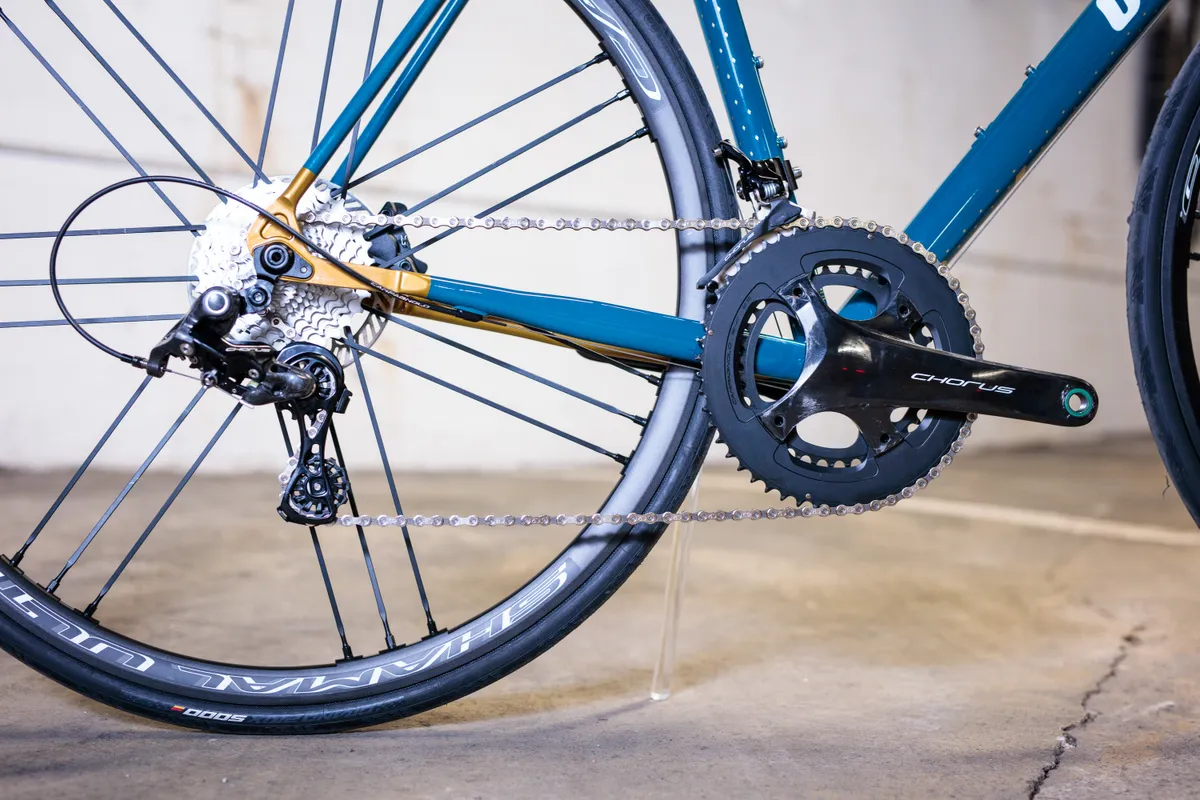
- Gearing: 12-speed
- Shifting: Mechanical
- Braking: Rim, hydraulic disc
Campagnolo quietly discontinued its entry-level Centaur groupset in June 2023, so the range now begins with 12-speed Campagnolo Chorus, which sits just below the Record family.
It uses light alloys, carbon fibre and titanium in its construction, and sits between Shimano Ultegra and Dura-Ace, or SRAM Force and SRAM Red.
Chorus offers a hydraulic disc brake option and handles cassettes with up to 11-34 teeth.
Pro-level Campagnolo groupsets: Record, Super Record and Super Record Wireless
Campagnolo Record
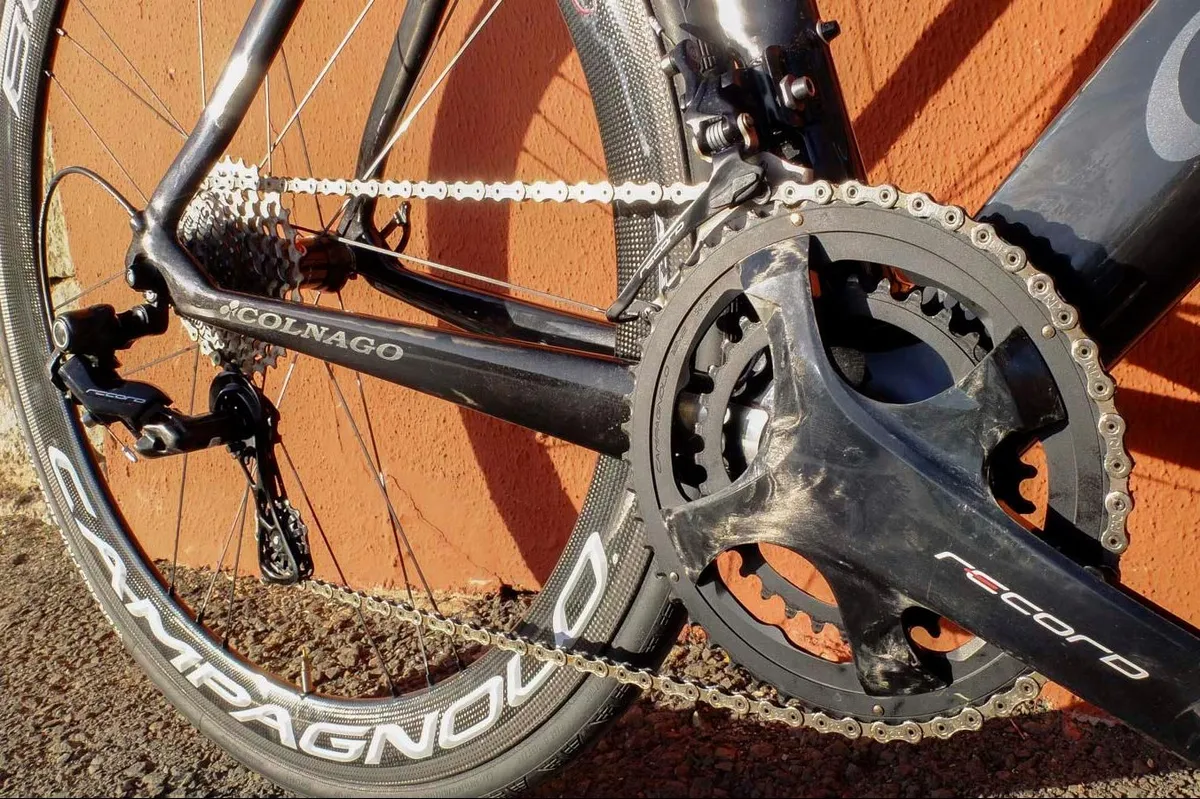
- Gearing: 12-speed
- Shifting: Mechanical
- Braking: Rim, hydraulic disc
Campagnolo Record is a premium mechanical groupset from the Italian brand, with 12-speed shifting, and rim and hydraulic disc braking options.
Campagnolo Super Record

- Gearing: 12-speed
- Shifting: Mechanical
- Braking: Rim, hydraulic disc
Campagnolo also offers an even higher-level groupset in the form of Super Record. While very similar to Record, it uses even fancier materials to lighten and enhance each and every part.
Campagnolo Super Record Wireless
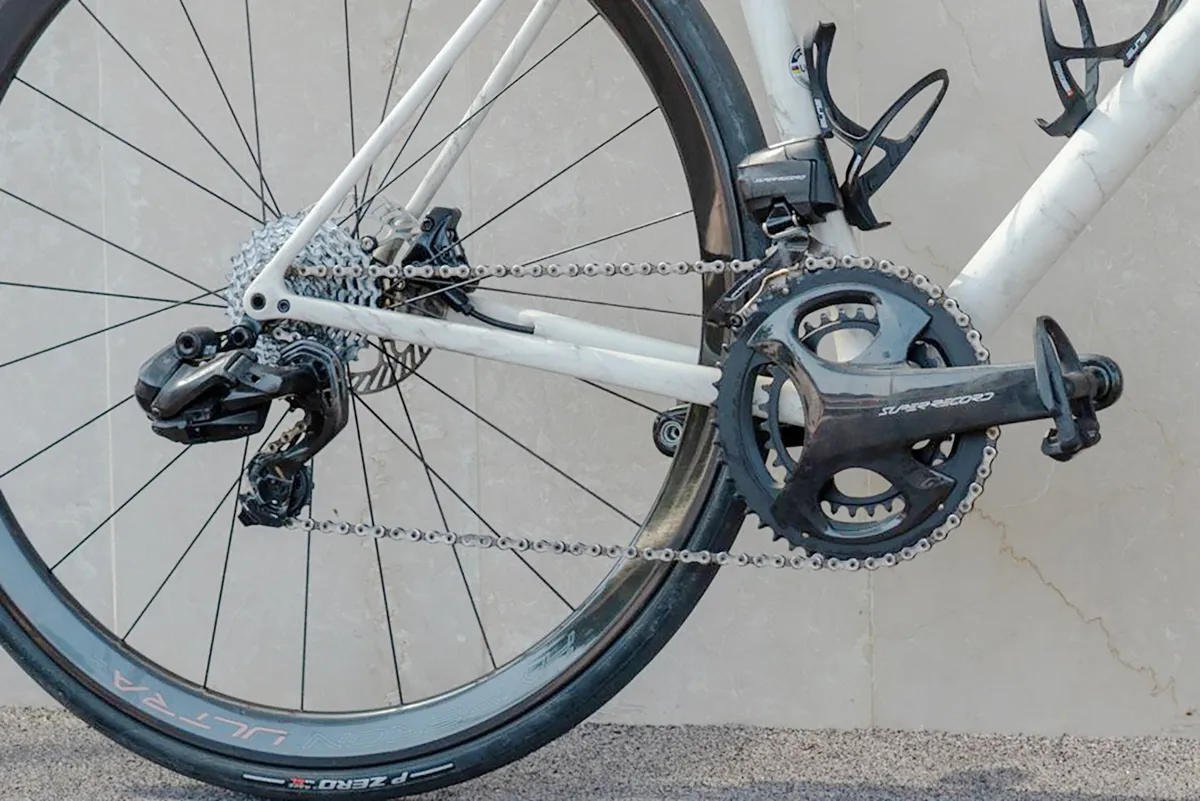
- Gearing: 12-speed
- Shifting: Electronic
- Braking: Hydraulic disc
Campagnolo's Super Record Wireless replaces its previous wired EPS electronic groupsets. The 12-speed groupset uses a 10t starting cassette cog and ditches the brand's iconic thumb shifter, introducing a new shifting logic.
This is the best of the best as far as Campagnolo is concerned and is usually only found on the most expensive pro-level road machines.
Road bike groupset components
Now we know how the different groupsets stack up, let's look at the individual components to be found in a groupset.
We'll explain the key differences between the different brands and what high-end features to look out for.
Road bike crankset/chainset explained
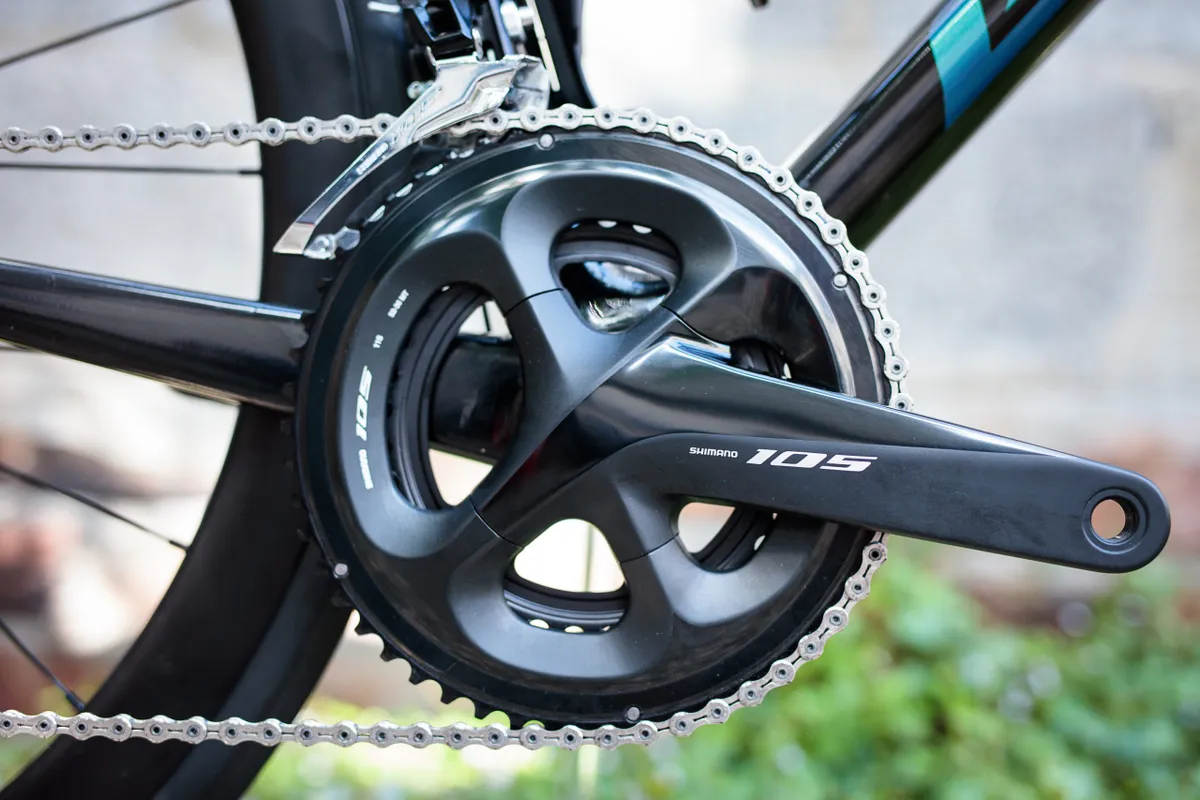
Single, double and triple chainrings
The crankset (or chainset) is the largest part of any groupset and comprises the chainrings, the cranks and, in most cases these days, the spindle that links the two crank arms together.
Cranksets are grouped into three categories based on the number of chainrings used: double (the most common on the road, often referred to as 2x or 1x/'one-by'); single (popular in mountain biking and cyclocross/gravel, and often referred to as 1x or 'one-by'); and triple (an older standard that's rarely seen on new bikes).
Double crankset variations
- The standard double crankset is most commonly used by pro riders and historically consists of a 53t big ring and 39t small ring, or 53/39
- The semi-compact crankset – or pro-compact – is 52/36. This gives you a slightly easier climbing gear while still retaining a big top gear. It is a popular option among competitive amateur riders
- The compact crankset is 50/34. It has become very popular thanks to its combination of easy gearing and low weight
- Super-compact or sub-compact cranksets offer an even lower gear range on double chainrings, such as 48t/32, 48/31 or 46/30. These are becoming popular with gravel riders and bikepackers who want the low, closely spaced gearing a 2x setup can offer.
- SRAM upset the applecart when it went 12-speed and introduced cassettes with a 10t small cog, rather than 11 teeth. That lets it achieve similar gear ratios with smaller chainrings, saving weight and offering even wider ranges. SRAM's second-tier Force eTap AXS groupset now includes a low-range 43/30t option, for example.
Triple cranksets
- The triple is an older type of chainset commonly seen on vintage road bikes and touring bikes. It offers a wide range of gears, but at a weight penalty by adding a third chainring. It typically combines a 50t outer ring, a 39t middle ring and an inner ring that has just 30 teeth. It is popular with touring cyclists who value a super-small 'spinny' ring when loaded down with panniers.
Single cranksets
- The single-ring crankset has only one chainring. To compensate for the loss of the smaller, inner ring, a 1× crankset is often matched to a wider-range cassette. Single ring cranksets use alternating wide and narrow teeth with a higher profile, to aid chain retention.
Road bike shifters explained
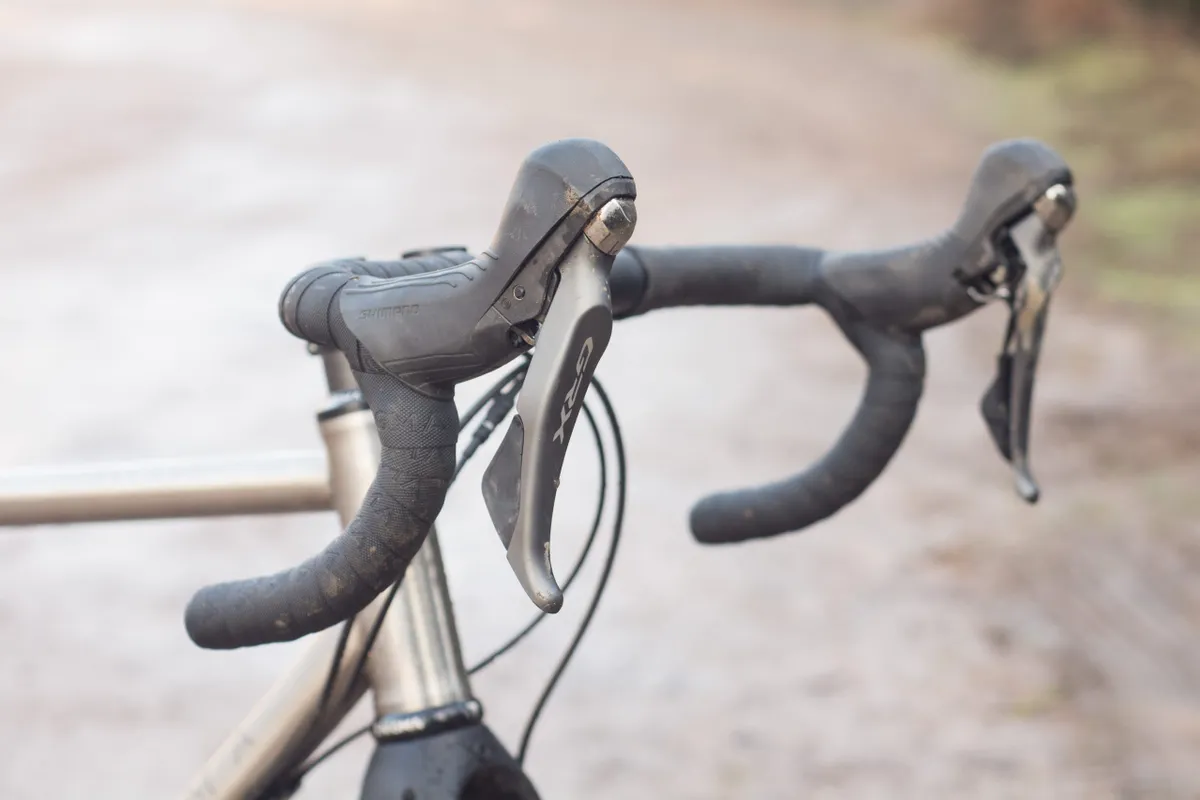
For the most part, modern road bikes use dual-action shifters that incorporate the gear levers into the brake levers.
Each brand has its own spin on the concept, so how you shift mechanical gears on a Shimano-equipped bike is slightly different to how you shift on a Campagnolo- or SRAM-equipped bike.
Electronic shifting still relies on paddles built into the brake levers but uses small servomotors in the derailleurs to make them move.
Electronic drivetrains offer consistently precise shifting and lower maintenance than a mechanically actuated drivetrain.
For a full explanation of how the different systems change gear, read our detailed article on how to change gear on a road bike.
Road bike brakes explained
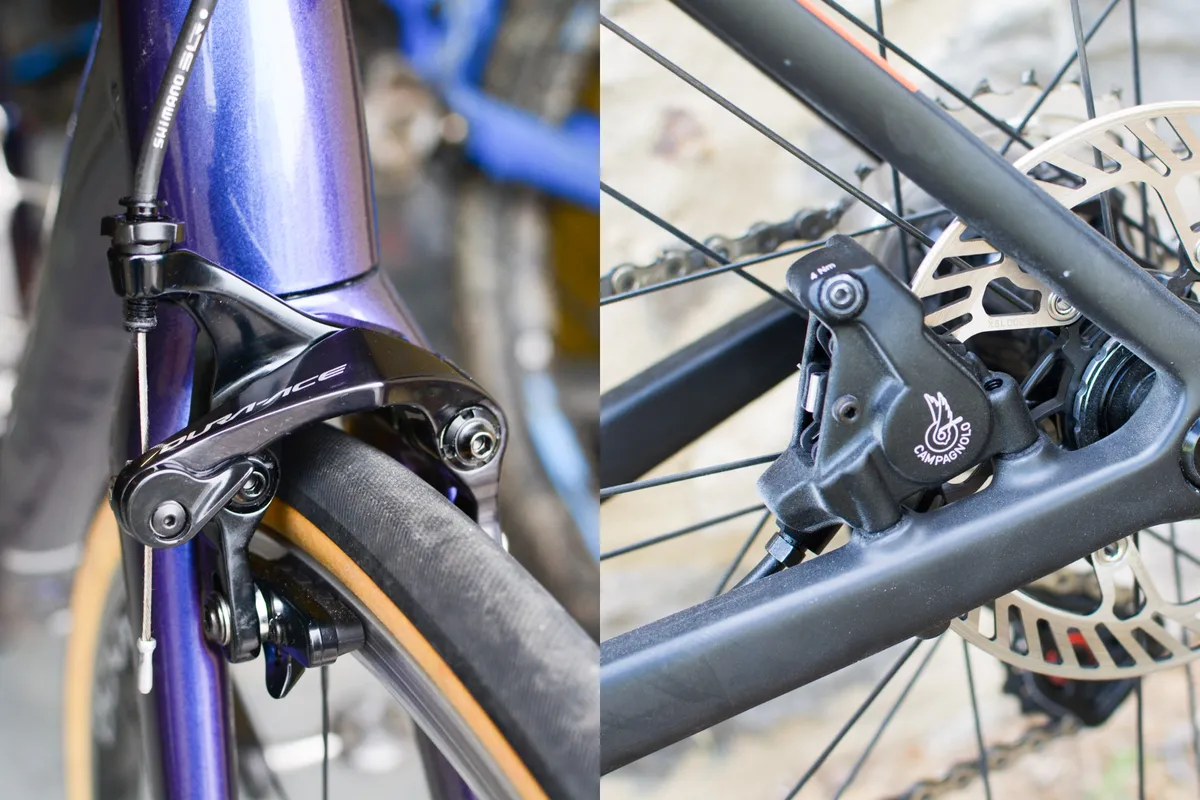
The complications don’t end with the various shift actions and whether they’re mechanically or electronically actuated. The variety of brakes used on road bikes has also grown more complex in the last few years.
In the past, cable-operated, caliper rim brakes were the only type used on most road bikes, but recent years have seen road bike braking options expand to take in direct-mount rim calipers, hydraulic rim calipers (these remain exceptionally rare), cable-operated disc brakes and hydraulic disc brakes.
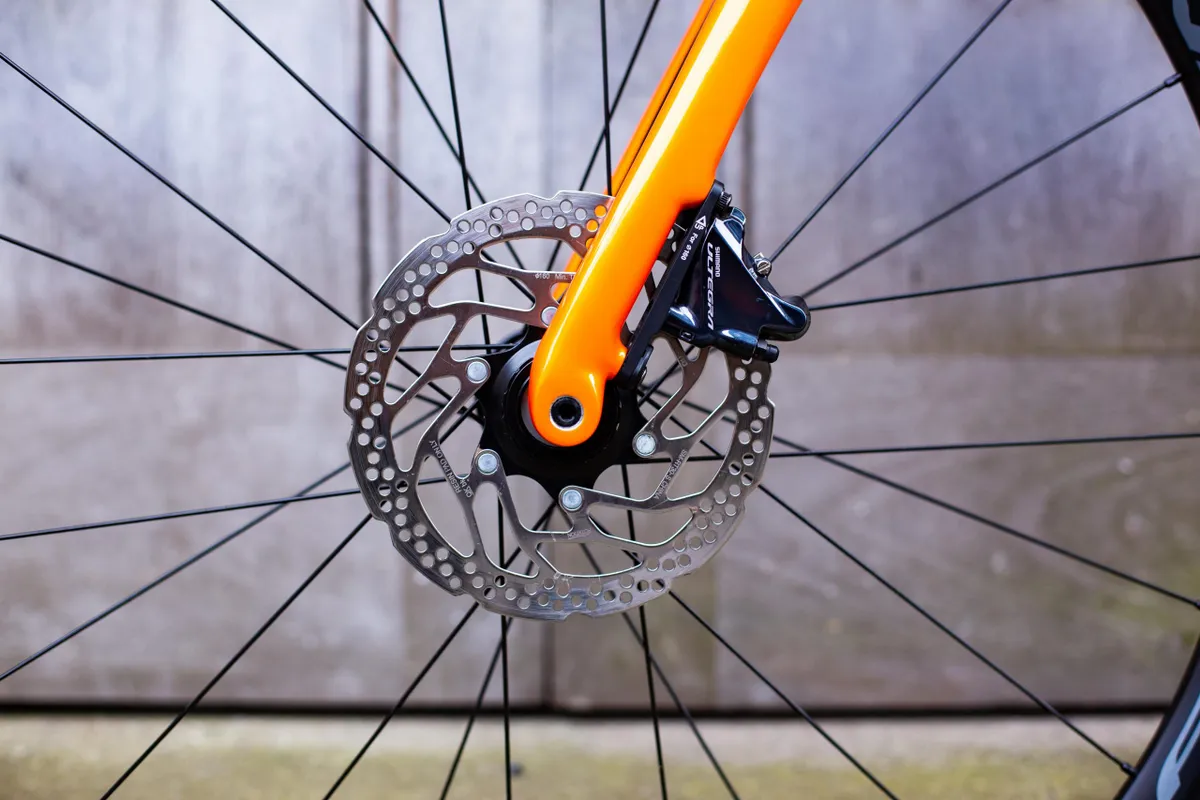
Hydraulic disc brakes are generally considered to be the best all-round option, but which type of brake is best for you is dependent on a number of factors. Understanding how road disc brakes work will help you decide.
All three groupset brands now offer hydraulic disc brake options alongside rim brakes for the majority of their groupsets, and they're now dominant on new bikes.
Road bike derailleurs explained
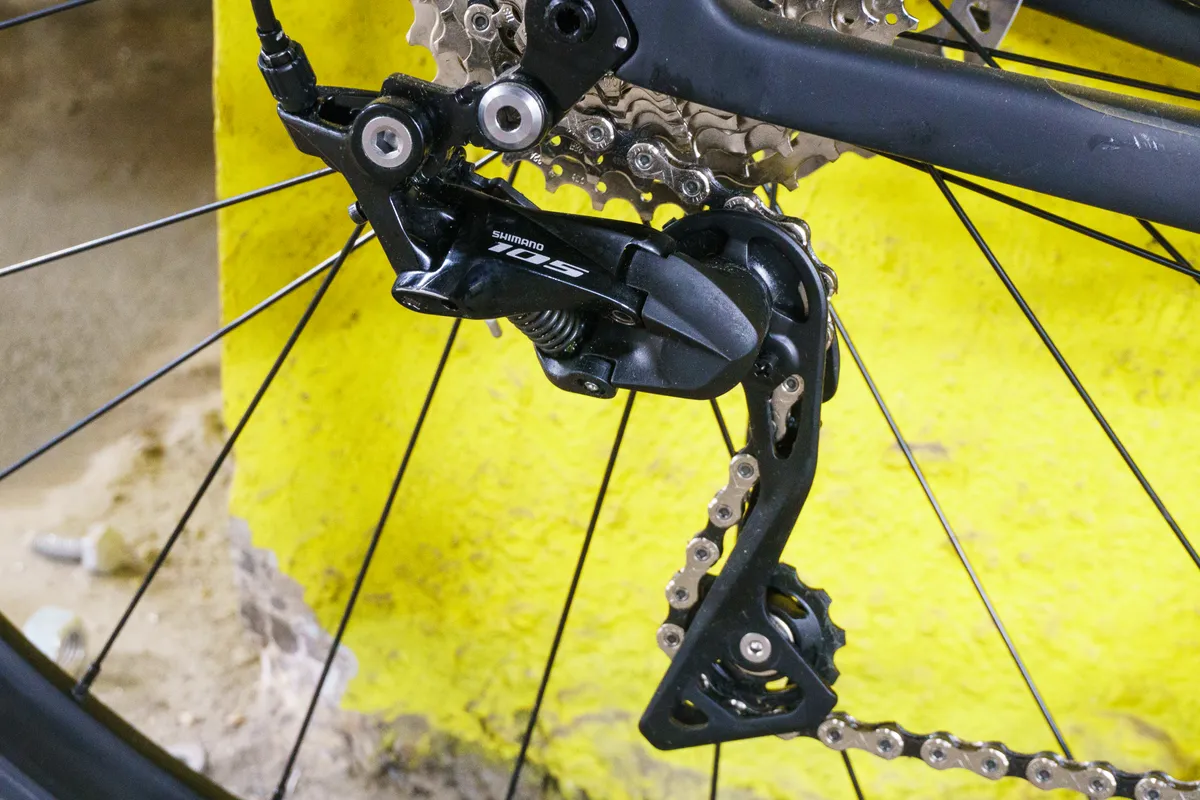
The derailleurs are the mechanisms – sometimes mech for short – that move the chain from one gear to the next.
The front derailleur does the job for the front chainrings, while the rear derailleur does it for the cassette; both are controlled by the shifters.
Road bike cassettes explained
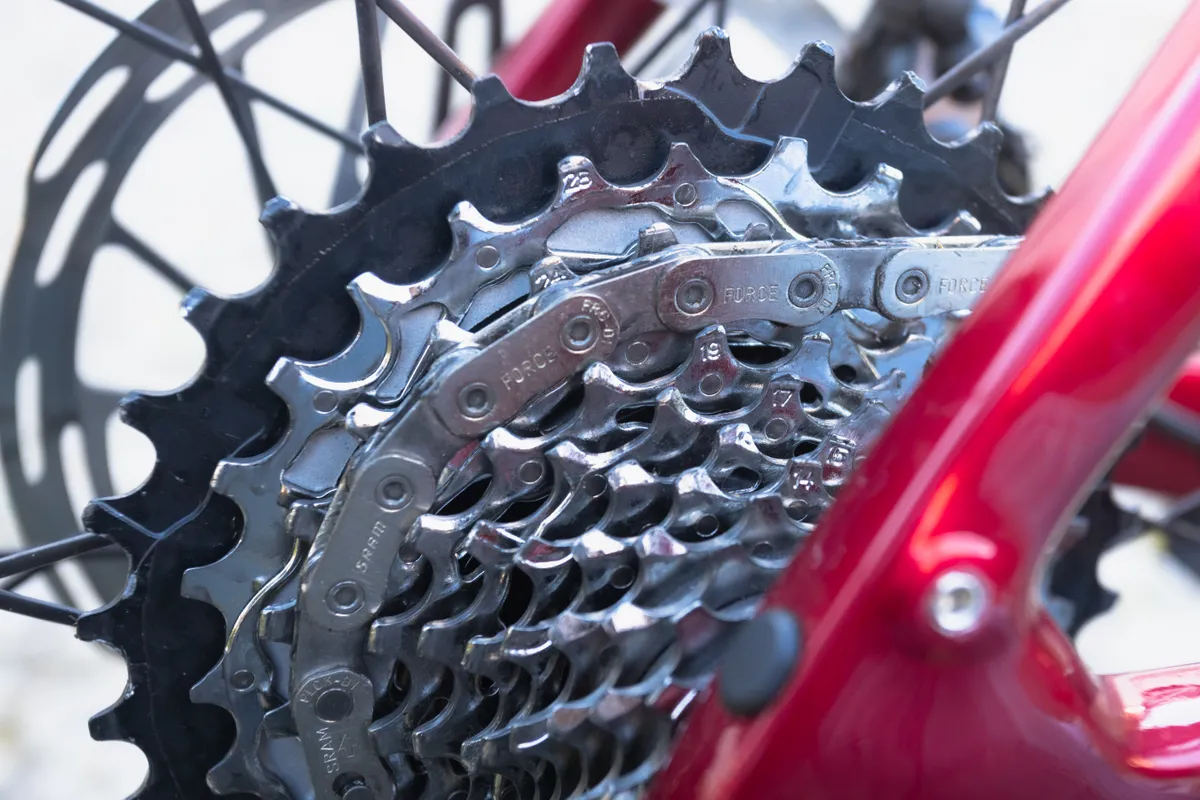
The cassette is the cluster of sprockets mounted on the rear wheel. The more sprockets on a cassette, the more ‘speeds’ the groupset is said to have.
So, if there are 10 sprockets, you have a 10-speed groupset; 11 sprockets is an 11-speed groupset, and so on.
(Note: ‘speeds’ only refers to the number of sprockets, not the total number of gears available; for that, you’d need to factor in the number of chainrings on the crankset.)
Having more sprockets not only provides you with a wider range of gears but also means the jumps between them tend to be smaller.
Smaller gaps mean it’s easier to maintain an optimal pedalling cadence as you shift from one gear to the next, and are therefore preferred by racers.
For road bikes with a double crankset, 11-28t is probably the most common cassette range, but Shimano, SRAM and Campagnolo all offer a huge range of choices to suit your riding.
It's also becoming more common to see wider range cassettes fitted as standard, with ratios such as 11-32t or even 11-34t appearing on some bikes, while SRAM offers a 10-36t 12-speed cassette in its eTap AXS Force and Rival ranges.
Road bike chains explained
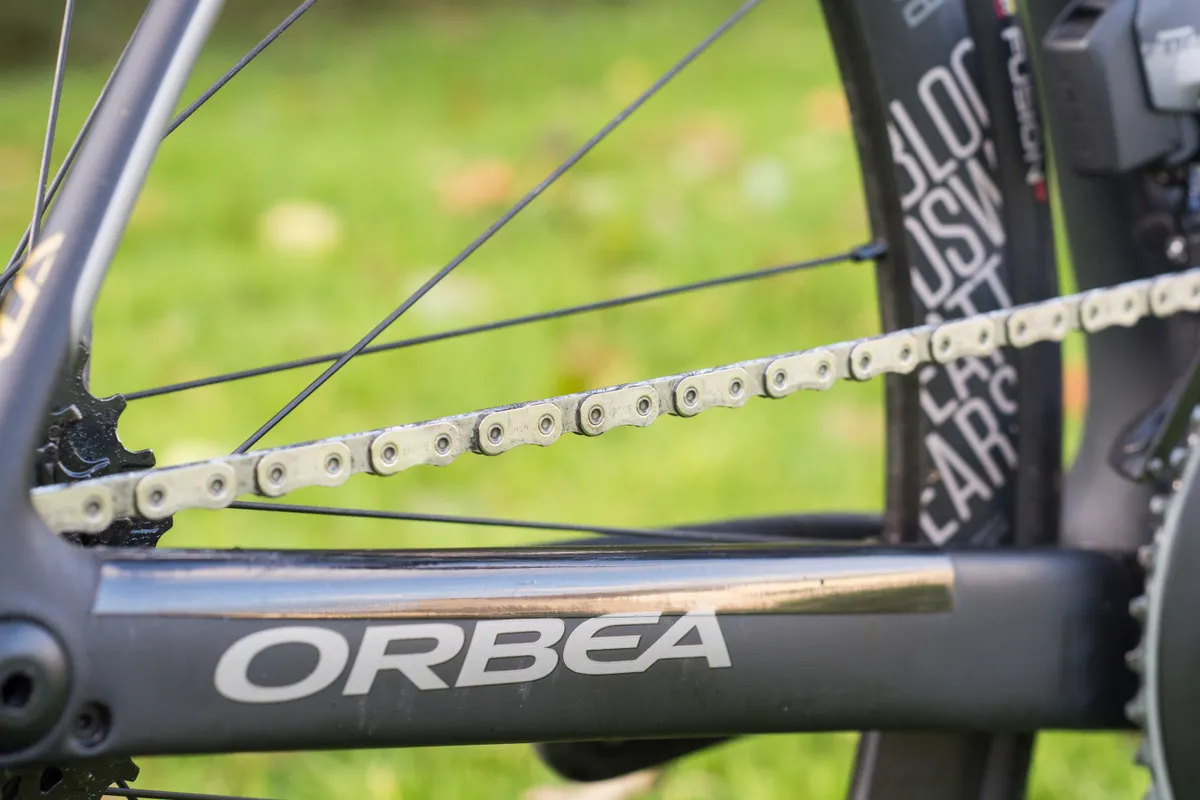
The groupset brand and number of gears dictate the type of bike chain you require (groupsets with a 'higher' number of gears require narrower chains).
More expensive chains also often have smoother, more durable and more corrosion-resistant coatings than their cheaper counterparts.
Additionally, some more expensive chains have the pins and plates drilled to remove weight.
Note that a chain is a wear item and should be replaced at regular intervals. There are tools that will tell you when to replace your bike's chain.
Failure to do this will accelerate wear on your cassette and chainrings, but you can extend chain life by cleaning it regularly and only using the best chain lubes for your bike.
Road bike bottom brackets explained
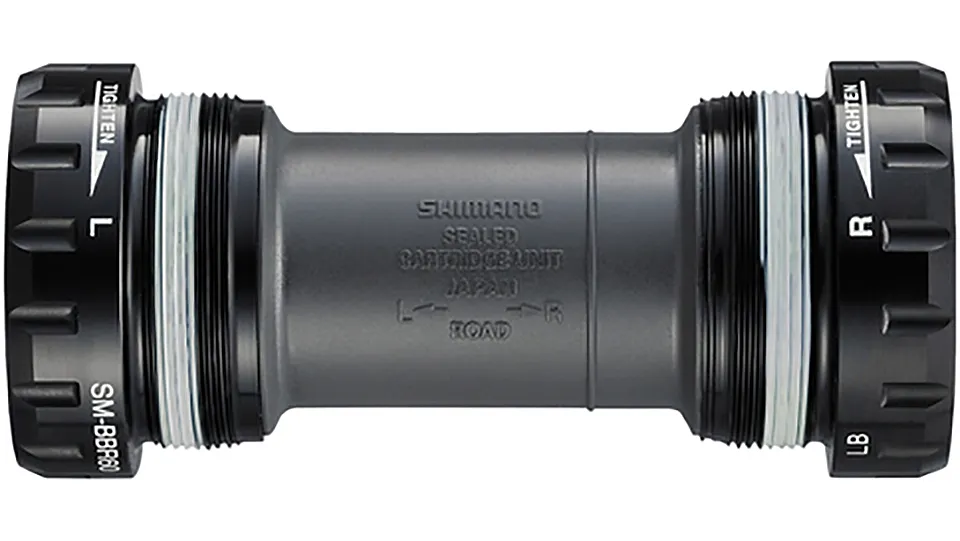
The bottom bracket contains the bearings on which the crankset spins and it fits into your frame.
Bottom brackets come in many shapes and sizes – we've got a complete guide to bottom bracket standards – but as far as road groupsets are concerned, they all fall into one of two categories: press-fit or threaded.
Threaded bottom brackets screw into your frame on threads. Press-fit bottom brackets, as the name suggests, are pressed into the frame and held in place by friction.
Generally speaking, press-fit bottom brackets are less convenient than threaded ones when it comes to maintenance and compatibility, but many manufacturers favour them for purported weight and stiffness benefits, as well as ease of manufacturing.
What do I get with a more expensive road groupset?
Does paying more always bring you improved performance? Maybe, but the higher up the range you go, the smaller those performance benefits become, and the increments become less noticeable, while the kit gets a lot more expensive.
Second-tier groupsets (Shimano Ultegra, Campagnolo Chorus, SRAM Force) are generally as good in functional terms as the pro-level components and considerably cheaper, but they weigh fractionally more and have fewer exotic shiny bits.
Weight
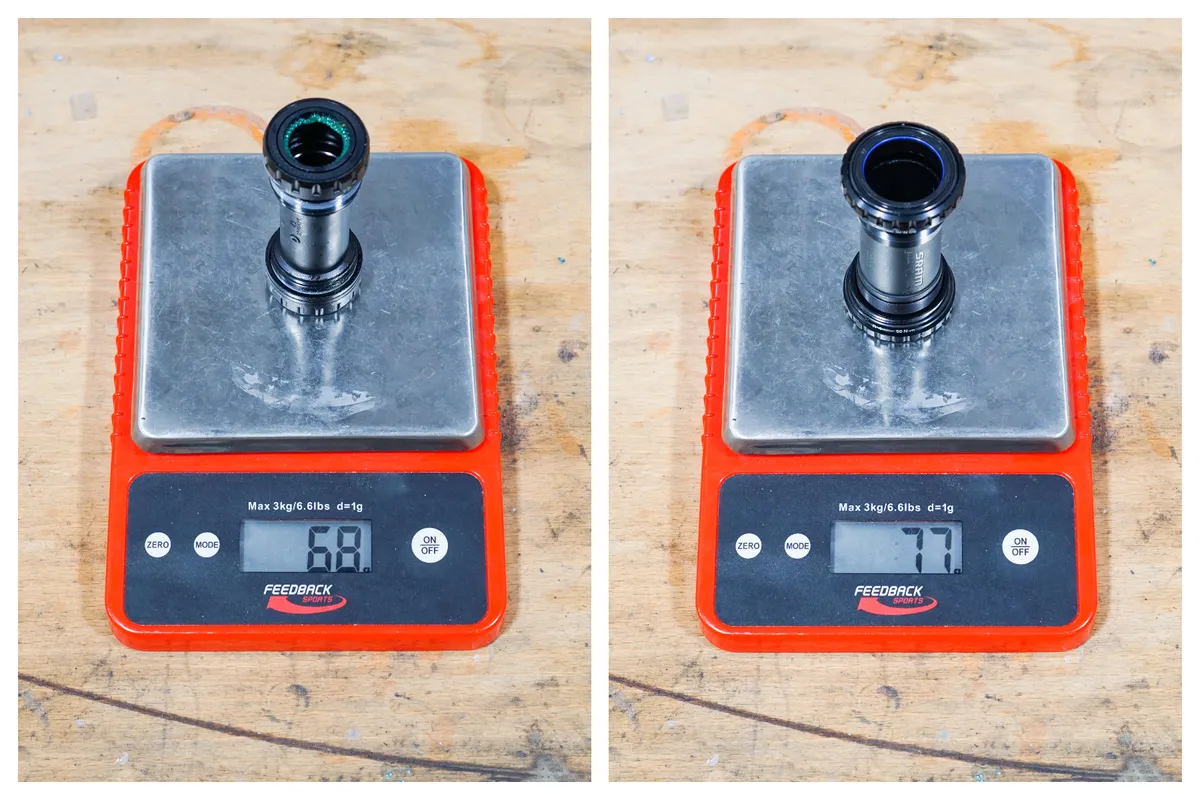
It was once famously said of bicycle parts: "Strong. Light. Cheap. Pick two." A lighter bike will always accelerate and climb better than a heavier one, but without giving up strength, something has to be compromised.
Whether you're looking at groupsets, wheels or even complete bikes, reduced weight is often the major contributor to increased cost.
With all the road groupsets, the more you spend, the lighter they get. The amount of weight that you save for your money diminishes dramatically at the upper end, though.
These weight differences are the result of more expensive materials and refined, or more time-consuming, manufacturing processes.
In addition to further machining, hole-drilling and high precision, more expensive components often use materials such as carbon fibre, titanium, lightweight aluminium and ceramic bearings to achieve the pinnacle in low weight and performance.
Durability
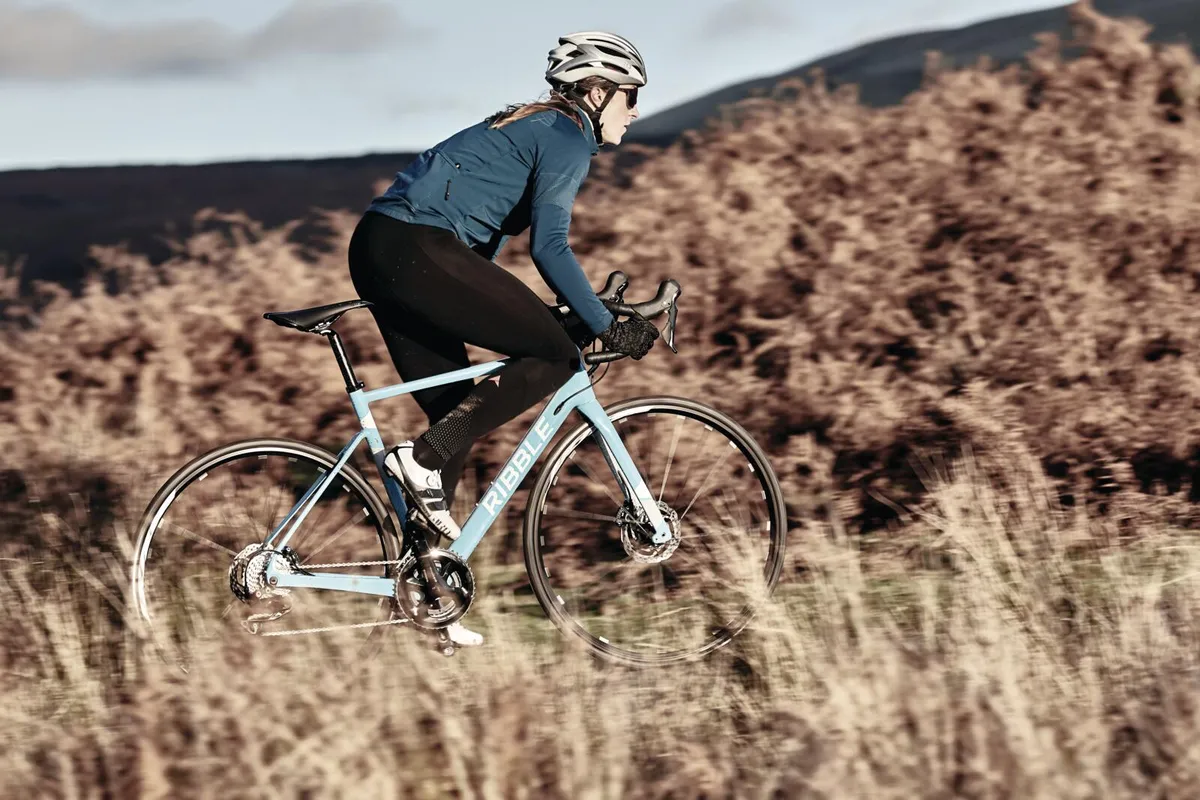
If you're spending more money on a groupset, you'd expect it to outlast a cheaper option. Durability does improve with price, but our experience is that durability also plateaus at the second-tier options, and in some ways, actually starts to decline at the most expensive option.
The more expensive technical components are built with greater precision, refinement and materials that lend themselves to greater longevity. This is apparent in derailleurs and shifters where the cheaper options will develop play and slop over time, while the better parts often remain like new.
Wear items, such as cassettes and chainrings, however, are often the reverse of this. Cheaper options are made of heavier but more durable steels, while the more expensive versions are sometimes made from lighter but softer aluminium or titanium alloys.
Performance
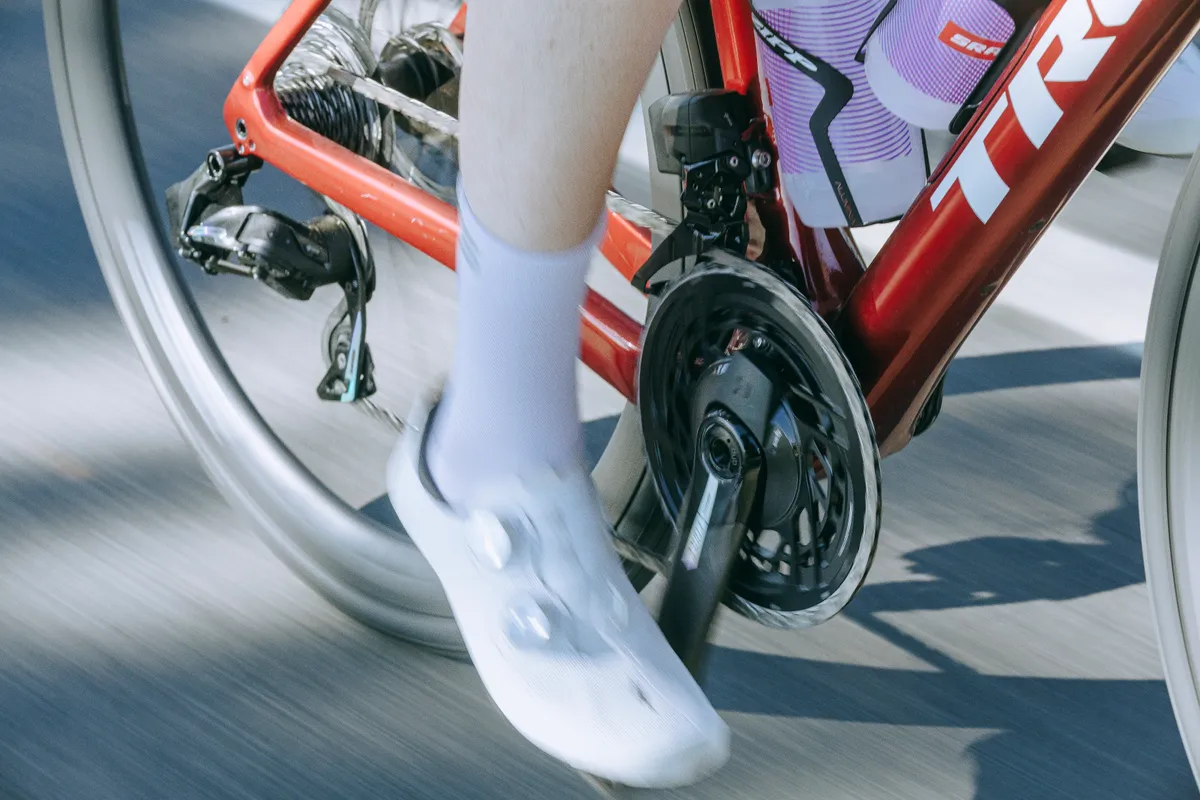
In addition to the benefits of reduced weight, more expensive groupsets find other ways of increasing performance. Most noticeably, higher-priced options provide a smoother, more precise and in some cases quicker shift between gears.
This includes reduced effort at the lever, something that becomes apparent once you've been on the bike for a few hours. It's an area where electronic gears set the benchmark; ultimate precision at the simple push of a button.
Another performance example is increased crankset stiffness to provide crisper shifting and more efficient power transfer from the pedals to the rear wheel. This is achieved with more complex designs, and materials that increase strength and stiffness, but don't add weight.
Braking raises an entire new list of benefits as prices go up. Simply put, more expensive brakes are stronger, offer better feel and control, and stop you with less hand force required.
This difference is much more apparent with rim brakes, though. There's hardly any meaningful performance difference between low- and high-end hydraulic disc brakes.
Additional features
Besides offering extra gears, the more expensive groupsets usually get new features first.
Shimano first launched Di2 electronic shifting at the Dura-Ace level, before trickling it down to Ultegra. The same is true of more mundane details – Dura-Ace was the first to get reach adjustment using a built-in screw rather than ugly shims, a feature now found all the way down to Claris level.
Similarly, Shimano and Campagnolo now offer their higher-end cranksets in a universal size that's cross-compatible with its range of chainrings. This means if you ever wish to change your chainring sizes, you can do so without needing a new crankset.
Groupset compatibility issues
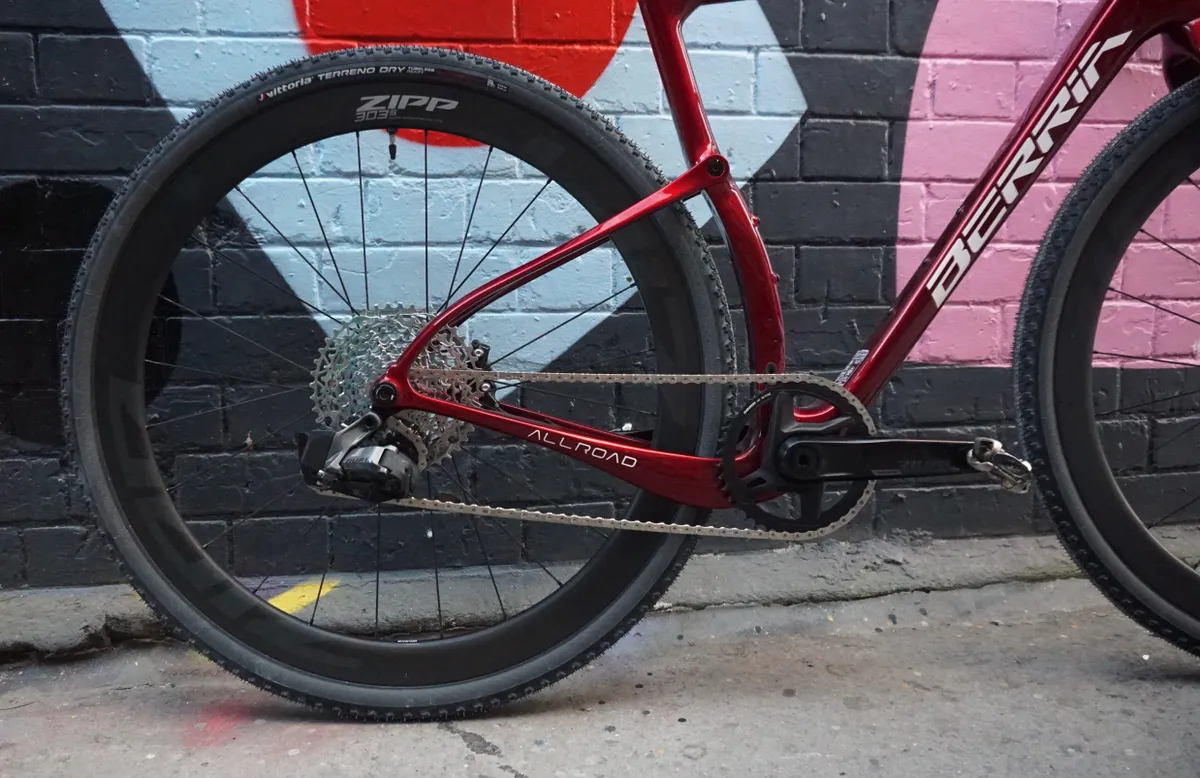
It's worth being aware that not all groupset components from a given manufacturer are compatible with one another, even in cases where it seems like they should be.
Manufacturers tend to update their ranges incrementally over time so you can't always assume, for example, that one 11-speed component will work with another if they're not from the same year or groupset.
There are differences in the precise amount of cable pulled by different rim brake levers too, so you may not get optimal performance if you move up the hierarchy when you replace individual parts.
That said, groupsets of a given brand are generally designed to work with each other, providing they share the same number of gears. (i.e. Shimano 11-speed with Shimano 11-speed, Campagnolo 11-speed with Campagnolo 11-speed.)
For specific compatibility queries, we'd suggest you ask your local retailer before buying, consult manufacturer technical documents online, or seek advice on our forum. Shimano, for example, maintains very detailed compatibility charts.
